Health and Safety Legislation in Health and Social Care: A Comprehensive Analysis
VerifiedAdded on 2024/05/17
|23
|7068
|458
AI Summary
This study delves into the implementation of health and safety legislation within the health and social care workplace, using Aldgate East Care Home as a case study. It examines risk assessment, policy development, and the impact of non-compliance on both employees and service users. The study also explores the importance of a positive safety culture and the role of communication in promoting a safe and healthy environment.
Contribute Materials
Your contribution can guide someone’s learning journey. Share your
documents today.
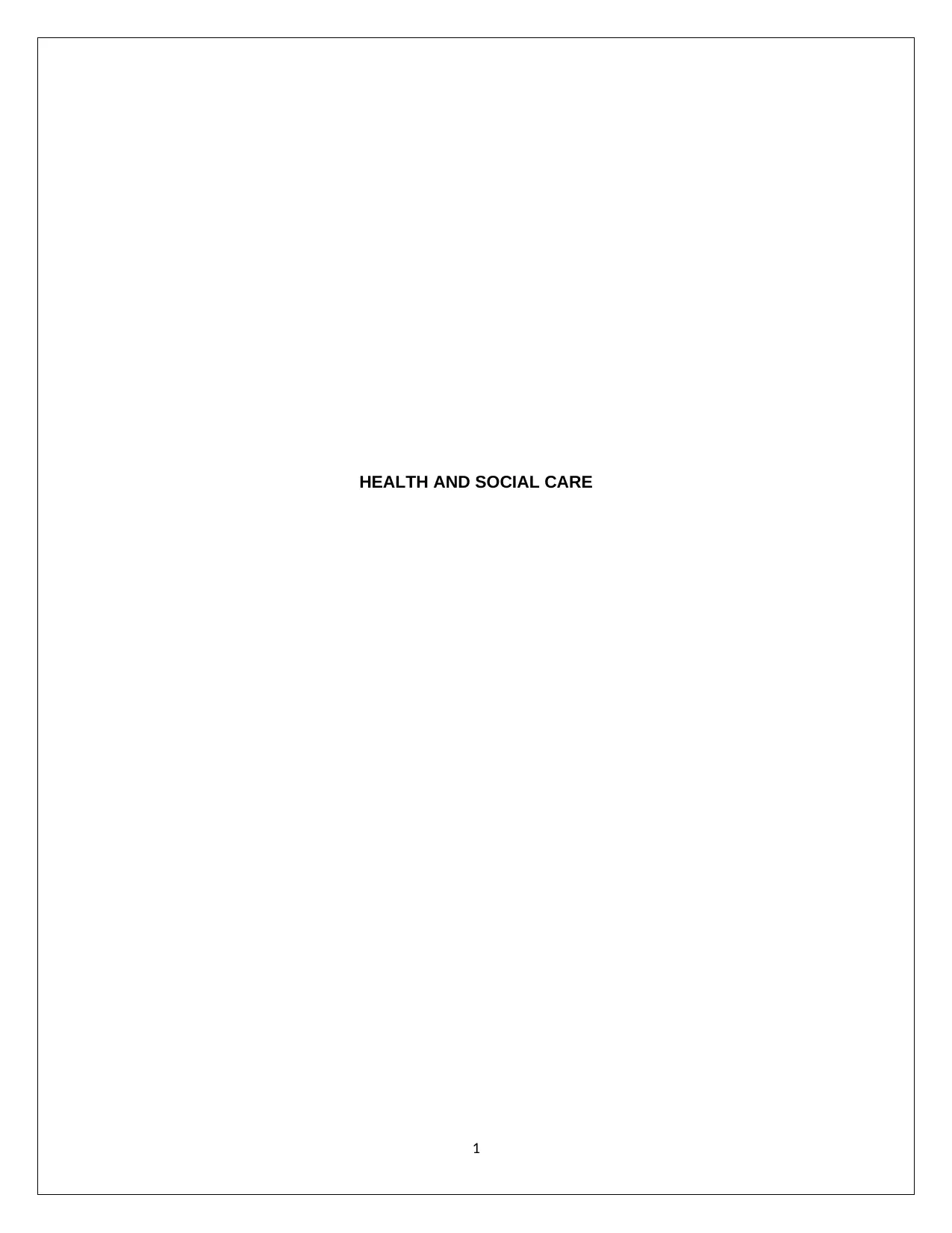
HEALTH AND SOCIAL CARE
1
1
Secure Best Marks with AI Grader
Need help grading? Try our AI Grader for instant feedback on your assignments.
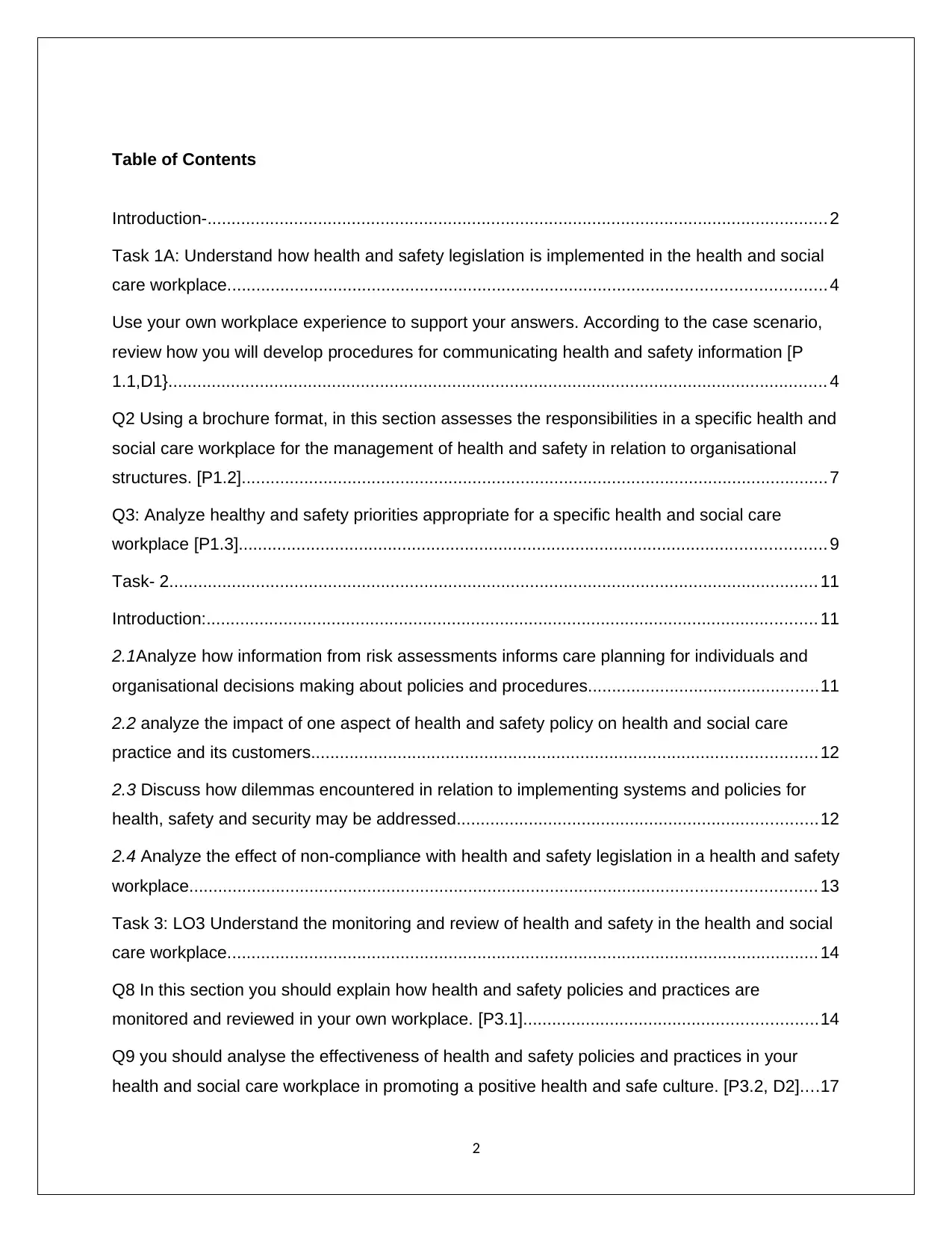
Table of Contents
Introduction-................................................................................................................................. 2
Task 1A: Understand how health and safety legislation is implemented in the health and social
care workplace............................................................................................................................ 4
Use your own workplace experience to support your answers. According to the case scenario,
review how you will develop procedures for communicating health and safety information [P
1.1,D1}......................................................................................................................................... 4
Q2 Using a brochure format, in this section assesses the responsibilities in a specific health and
social care workplace for the management of health and safety in relation to organisational
structures. [P1.2].......................................................................................................................... 7
Q3: Analyze healthy and safety priorities appropriate for a specific health and social care
workplace [P1.3].......................................................................................................................... 9
Task- 2....................................................................................................................................... 11
Introduction:............................................................................................................................... 11
2.1Analyze how information from risk assessments informs care planning for individuals and
organisational decisions making about policies and procedures................................................11
2.2 analyze the impact of one aspect of health and safety policy on health and social care
practice and its customers.........................................................................................................12
2.3 Discuss how dilemmas encountered in relation to implementing systems and policies for
health, safety and security may be addressed...........................................................................12
2.4 Analyze the effect of non-compliance with health and safety legislation in a health and safety
workplace.................................................................................................................................. 13
Task 3: LO3 Understand the monitoring and review of health and safety in the health and social
care workplace........................................................................................................................... 14
Q8 In this section you should explain how health and safety policies and practices are
monitored and reviewed in your own workplace. [P3.1].............................................................14
Q9 you should analyse the effectiveness of health and safety policies and practices in your
health and social care workplace in promoting a positive health and safe culture. [P3.2, D2]....17
2
Introduction-................................................................................................................................. 2
Task 1A: Understand how health and safety legislation is implemented in the health and social
care workplace............................................................................................................................ 4
Use your own workplace experience to support your answers. According to the case scenario,
review how you will develop procedures for communicating health and safety information [P
1.1,D1}......................................................................................................................................... 4
Q2 Using a brochure format, in this section assesses the responsibilities in a specific health and
social care workplace for the management of health and safety in relation to organisational
structures. [P1.2].......................................................................................................................... 7
Q3: Analyze healthy and safety priorities appropriate for a specific health and social care
workplace [P1.3].......................................................................................................................... 9
Task- 2....................................................................................................................................... 11
Introduction:............................................................................................................................... 11
2.1Analyze how information from risk assessments informs care planning for individuals and
organisational decisions making about policies and procedures................................................11
2.2 analyze the impact of one aspect of health and safety policy on health and social care
practice and its customers.........................................................................................................12
2.3 Discuss how dilemmas encountered in relation to implementing systems and policies for
health, safety and security may be addressed...........................................................................12
2.4 Analyze the effect of non-compliance with health and safety legislation in a health and safety
workplace.................................................................................................................................. 13
Task 3: LO3 Understand the monitoring and review of health and safety in the health and social
care workplace........................................................................................................................... 14
Q8 In this section you should explain how health and safety policies and practices are
monitored and reviewed in your own workplace. [P3.1].............................................................14
Q9 you should analyse the effectiveness of health and safety policies and practices in your
health and social care workplace in promoting a positive health and safe culture. [P3.2, D2]....17
2
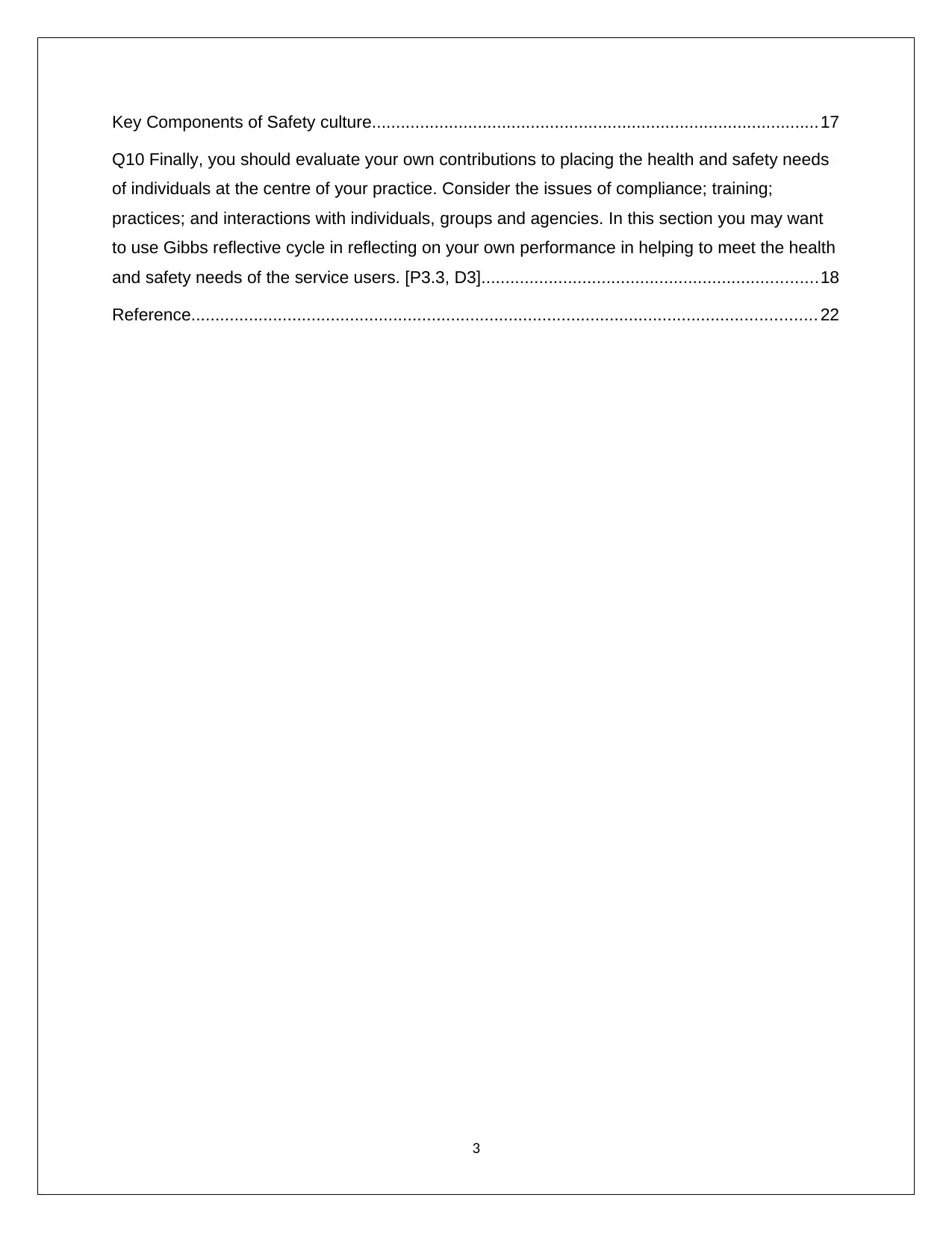
Key Components of Safety culture.............................................................................................17
Q10 Finally, you should evaluate your own contributions to placing the health and safety needs
of individuals at the centre of your practice. Consider the issues of compliance; training;
practices; and interactions with individuals, groups and agencies. In this section you may want
to use Gibbs reflective cycle in reflecting on your own performance in helping to meet the health
and safety needs of the service users. [P3.3, D3]......................................................................18
Reference.................................................................................................................................. 22
3
Q10 Finally, you should evaluate your own contributions to placing the health and safety needs
of individuals at the centre of your practice. Consider the issues of compliance; training;
practices; and interactions with individuals, groups and agencies. In this section you may want
to use Gibbs reflective cycle in reflecting on your own performance in helping to meet the health
and safety needs of the service users. [P3.3, D3]......................................................................18
Reference.................................................................................................................................. 22
3
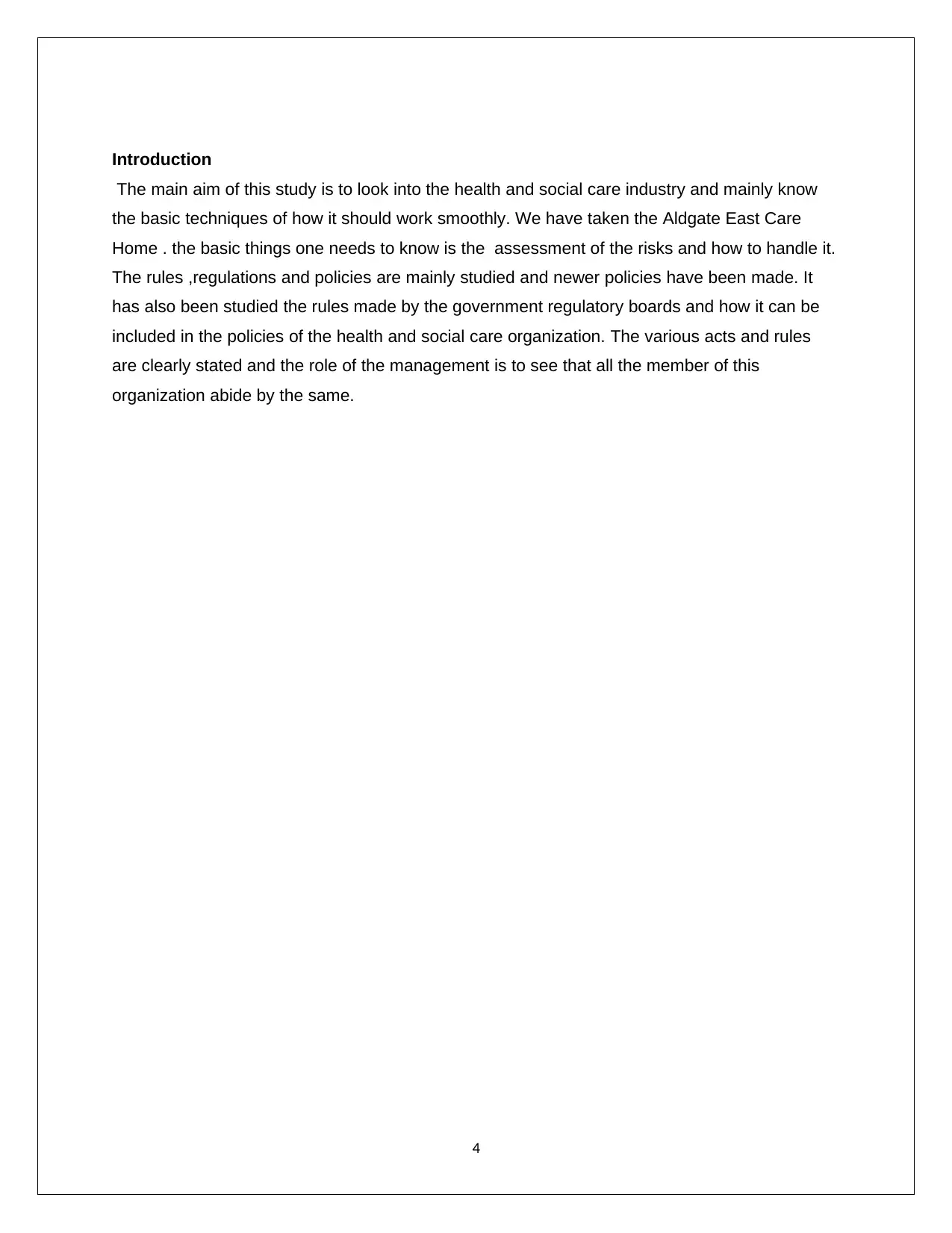
Introduction
The main aim of this study is to look into the health and social care industry and mainly know
the basic techniques of how it should work smoothly. We have taken the Aldgate East Care
Home . the basic things one needs to know is the assessment of the risks and how to handle it.
The rules ,regulations and policies are mainly studied and newer policies have been made. It
has also been studied the rules made by the government regulatory boards and how it can be
included in the policies of the health and social care organization. The various acts and rules
are clearly stated and the role of the management is to see that all the member of this
organization abide by the same.
4
The main aim of this study is to look into the health and social care industry and mainly know
the basic techniques of how it should work smoothly. We have taken the Aldgate East Care
Home . the basic things one needs to know is the assessment of the risks and how to handle it.
The rules ,regulations and policies are mainly studied and newer policies have been made. It
has also been studied the rules made by the government regulatory boards and how it can be
included in the policies of the health and social care organization. The various acts and rules
are clearly stated and the role of the management is to see that all the member of this
organization abide by the same.
4
Secure Best Marks with AI Grader
Need help grading? Try our AI Grader for instant feedback on your assignments.
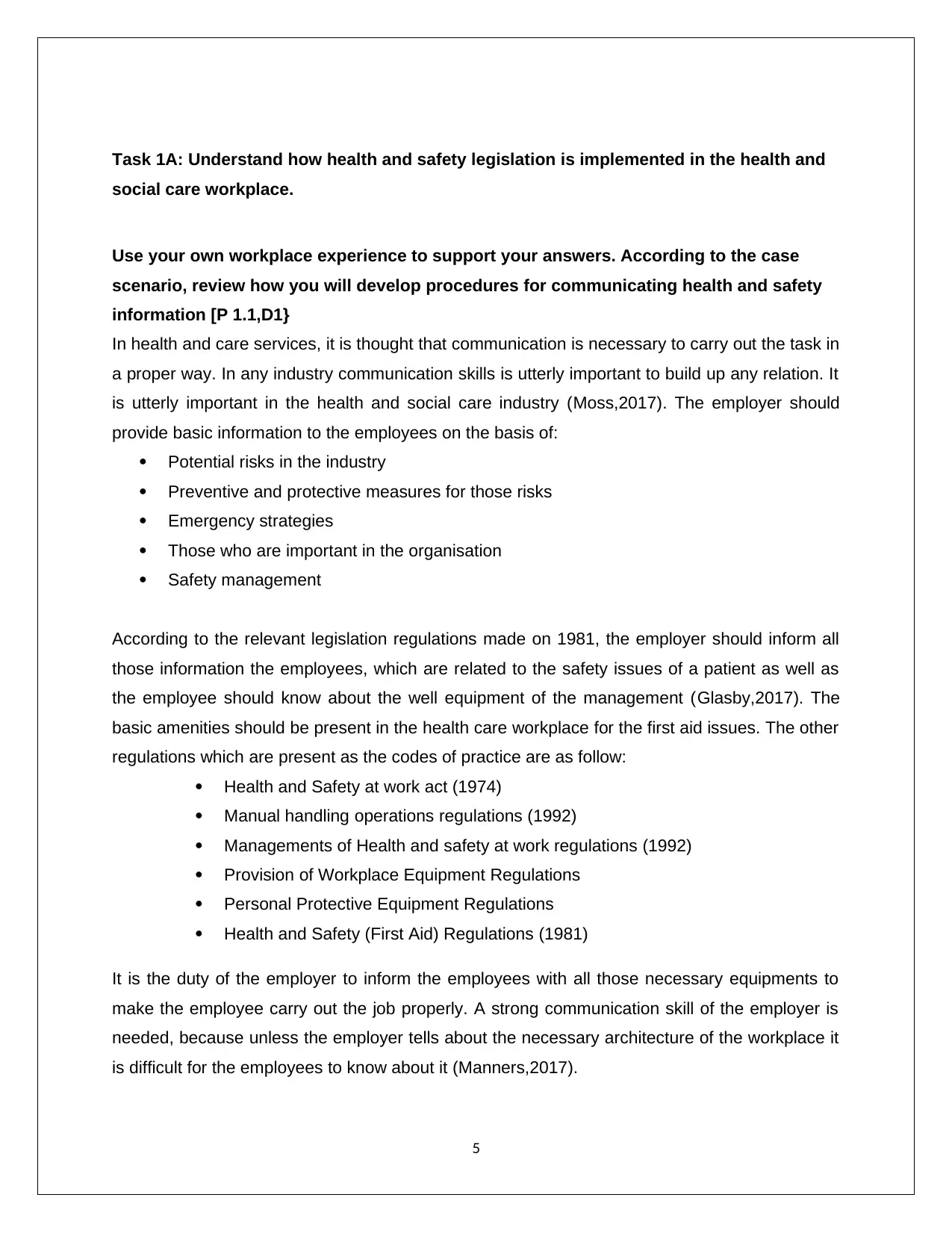
Task 1A: Understand how health and safety legislation is implemented in the health and
social care workplace.
Use your own workplace experience to support your answers. According to the case
scenario, review how you will develop procedures for communicating health and safety
information [P 1.1,D1}
In health and care services, it is thought that communication is necessary to carry out the task in
a proper way. In any industry communication skills is utterly important to build up any relation. It
is utterly important in the health and social care industry (Moss,2017). The employer should
provide basic information to the employees on the basis of:
Potential risks in the industry
Preventive and protective measures for those risks
Emergency strategies
Those who are important in the organisation
Safety management
According to the relevant legislation regulations made on 1981, the employer should inform all
those information the employees, which are related to the safety issues of a patient as well as
the employee should know about the well equipment of the management (Glasby,2017). The
basic amenities should be present in the health care workplace for the first aid issues. The other
regulations which are present as the codes of practice are as follow:
Health and Safety at work act (1974)
Manual handling operations regulations (1992)
Managements of Health and safety at work regulations (1992)
Provision of Workplace Equipment Regulations
Personal Protective Equipment Regulations
Health and Safety (First Aid) Regulations (1981)
It is the duty of the employer to inform the employees with all those necessary equipments to
make the employee carry out the job properly. A strong communication skill of the employer is
needed, because unless the employer tells about the necessary architecture of the workplace it
is difficult for the employees to know about it (Manners,2017).
5
social care workplace.
Use your own workplace experience to support your answers. According to the case
scenario, review how you will develop procedures for communicating health and safety
information [P 1.1,D1}
In health and care services, it is thought that communication is necessary to carry out the task in
a proper way. In any industry communication skills is utterly important to build up any relation. It
is utterly important in the health and social care industry (Moss,2017). The employer should
provide basic information to the employees on the basis of:
Potential risks in the industry
Preventive and protective measures for those risks
Emergency strategies
Those who are important in the organisation
Safety management
According to the relevant legislation regulations made on 1981, the employer should inform all
those information the employees, which are related to the safety issues of a patient as well as
the employee should know about the well equipment of the management (Glasby,2017). The
basic amenities should be present in the health care workplace for the first aid issues. The other
regulations which are present as the codes of practice are as follow:
Health and Safety at work act (1974)
Manual handling operations regulations (1992)
Managements of Health and safety at work regulations (1992)
Provision of Workplace Equipment Regulations
Personal Protective Equipment Regulations
Health and Safety (First Aid) Regulations (1981)
It is the duty of the employer to inform the employees with all those necessary equipments to
make the employee carry out the job properly. A strong communication skill of the employer is
needed, because unless the employer tells about the necessary architecture of the workplace it
is difficult for the employees to know about it (Manners,2017).
5
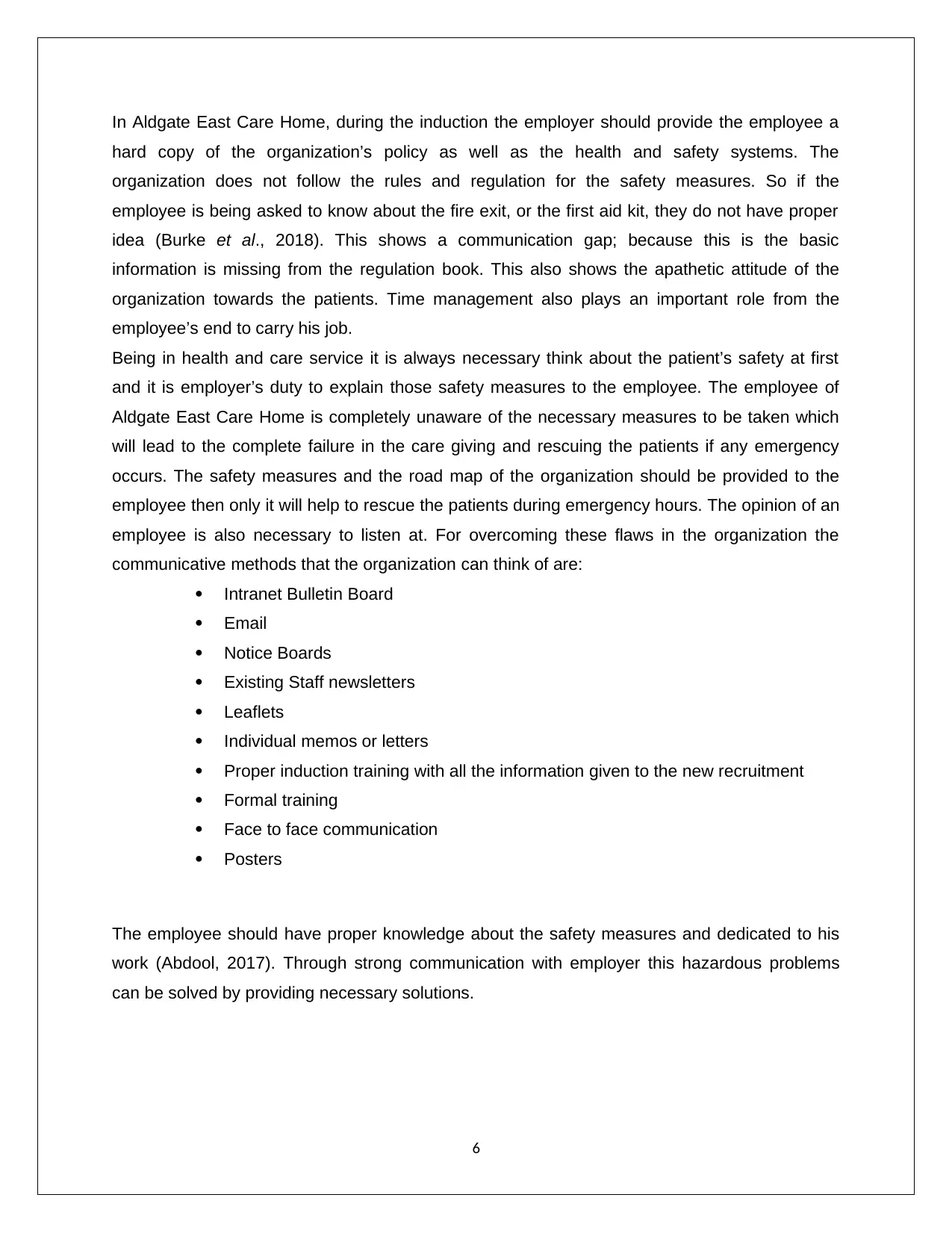
In Aldgate East Care Home, during the induction the employer should provide the employee a
hard copy of the organization’s policy as well as the health and safety systems. The
organization does not follow the rules and regulation for the safety measures. So if the
employee is being asked to know about the fire exit, or the first aid kit, they do not have proper
idea (Burke et al., 2018). This shows a communication gap; because this is the basic
information is missing from the regulation book. This also shows the apathetic attitude of the
organization towards the patients. Time management also plays an important role from the
employee’s end to carry his job.
Being in health and care service it is always necessary think about the patient’s safety at first
and it is employer’s duty to explain those safety measures to the employee. The employee of
Aldgate East Care Home is completely unaware of the necessary measures to be taken which
will lead to the complete failure in the care giving and rescuing the patients if any emergency
occurs. The safety measures and the road map of the organization should be provided to the
employee then only it will help to rescue the patients during emergency hours. The opinion of an
employee is also necessary to listen at. For overcoming these flaws in the organization the
communicative methods that the organization can think of are:
Intranet Bulletin Board
Email
Notice Boards
Existing Staff newsletters
Leaflets
Individual memos or letters
Proper induction training with all the information given to the new recruitment
Formal training
Face to face communication
Posters
The employee should have proper knowledge about the safety measures and dedicated to his
work (Abdool, 2017). Through strong communication with employer this hazardous problems
can be solved by providing necessary solutions.
6
hard copy of the organization’s policy as well as the health and safety systems. The
organization does not follow the rules and regulation for the safety measures. So if the
employee is being asked to know about the fire exit, or the first aid kit, they do not have proper
idea (Burke et al., 2018). This shows a communication gap; because this is the basic
information is missing from the regulation book. This also shows the apathetic attitude of the
organization towards the patients. Time management also plays an important role from the
employee’s end to carry his job.
Being in health and care service it is always necessary think about the patient’s safety at first
and it is employer’s duty to explain those safety measures to the employee. The employee of
Aldgate East Care Home is completely unaware of the necessary measures to be taken which
will lead to the complete failure in the care giving and rescuing the patients if any emergency
occurs. The safety measures and the road map of the organization should be provided to the
employee then only it will help to rescue the patients during emergency hours. The opinion of an
employee is also necessary to listen at. For overcoming these flaws in the organization the
communicative methods that the organization can think of are:
Intranet Bulletin Board
Notice Boards
Existing Staff newsletters
Leaflets
Individual memos or letters
Proper induction training with all the information given to the new recruitment
Formal training
Face to face communication
Posters
The employee should have proper knowledge about the safety measures and dedicated to his
work (Abdool, 2017). Through strong communication with employer this hazardous problems
can be solved by providing necessary solutions.
6
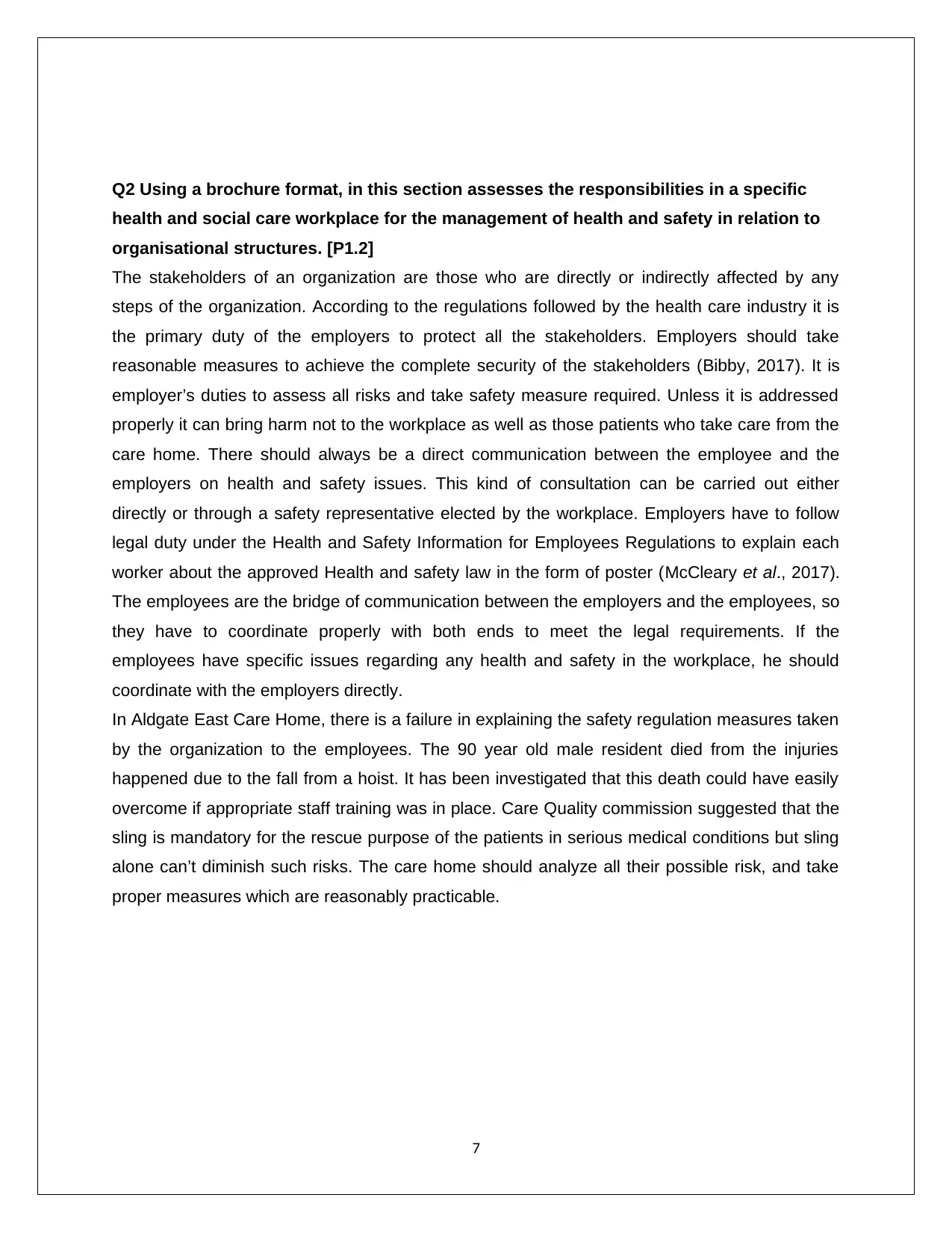
Q2 Using a brochure format, in this section assesses the responsibilities in a specific
health and social care workplace for the management of health and safety in relation to
organisational structures. [P1.2]
The stakeholders of an organization are those who are directly or indirectly affected by any
steps of the organization. According to the regulations followed by the health care industry it is
the primary duty of the employers to protect all the stakeholders. Employers should take
reasonable measures to achieve the complete security of the stakeholders (Bibby, 2017). It is
employer’s duties to assess all risks and take safety measure required. Unless it is addressed
properly it can bring harm not to the workplace as well as those patients who take care from the
care home. There should always be a direct communication between the employee and the
employers on health and safety issues. This kind of consultation can be carried out either
directly or through a safety representative elected by the workplace. Employers have to follow
legal duty under the Health and Safety Information for Employees Regulations to explain each
worker about the approved Health and safety law in the form of poster (McCleary et al., 2017).
The employees are the bridge of communication between the employers and the employees, so
they have to coordinate properly with both ends to meet the legal requirements. If the
employees have specific issues regarding any health and safety in the workplace, he should
coordinate with the employers directly.
In Aldgate East Care Home, there is a failure in explaining the safety regulation measures taken
by the organization to the employees. The 90 year old male resident died from the injuries
happened due to the fall from a hoist. It has been investigated that this death could have easily
overcome if appropriate staff training was in place. Care Quality commission suggested that the
sling is mandatory for the rescue purpose of the patients in serious medical conditions but sling
alone can’t diminish such risks. The care home should analyze all their possible risk, and take
proper measures which are reasonably practicable.
7
health and social care workplace for the management of health and safety in relation to
organisational structures. [P1.2]
The stakeholders of an organization are those who are directly or indirectly affected by any
steps of the organization. According to the regulations followed by the health care industry it is
the primary duty of the employers to protect all the stakeholders. Employers should take
reasonable measures to achieve the complete security of the stakeholders (Bibby, 2017). It is
employer’s duties to assess all risks and take safety measure required. Unless it is addressed
properly it can bring harm not to the workplace as well as those patients who take care from the
care home. There should always be a direct communication between the employee and the
employers on health and safety issues. This kind of consultation can be carried out either
directly or through a safety representative elected by the workplace. Employers have to follow
legal duty under the Health and Safety Information for Employees Regulations to explain each
worker about the approved Health and safety law in the form of poster (McCleary et al., 2017).
The employees are the bridge of communication between the employers and the employees, so
they have to coordinate properly with both ends to meet the legal requirements. If the
employees have specific issues regarding any health and safety in the workplace, he should
coordinate with the employers directly.
In Aldgate East Care Home, there is a failure in explaining the safety regulation measures taken
by the organization to the employees. The 90 year old male resident died from the injuries
happened due to the fall from a hoist. It has been investigated that this death could have easily
overcome if appropriate staff training was in place. Care Quality commission suggested that the
sling is mandatory for the rescue purpose of the patients in serious medical conditions but sling
alone can’t diminish such risks. The care home should analyze all their possible risk, and take
proper measures which are reasonably practicable.
7
Paraphrase This Document
Need a fresh take? Get an instant paraphrase of this document with our AI Paraphraser
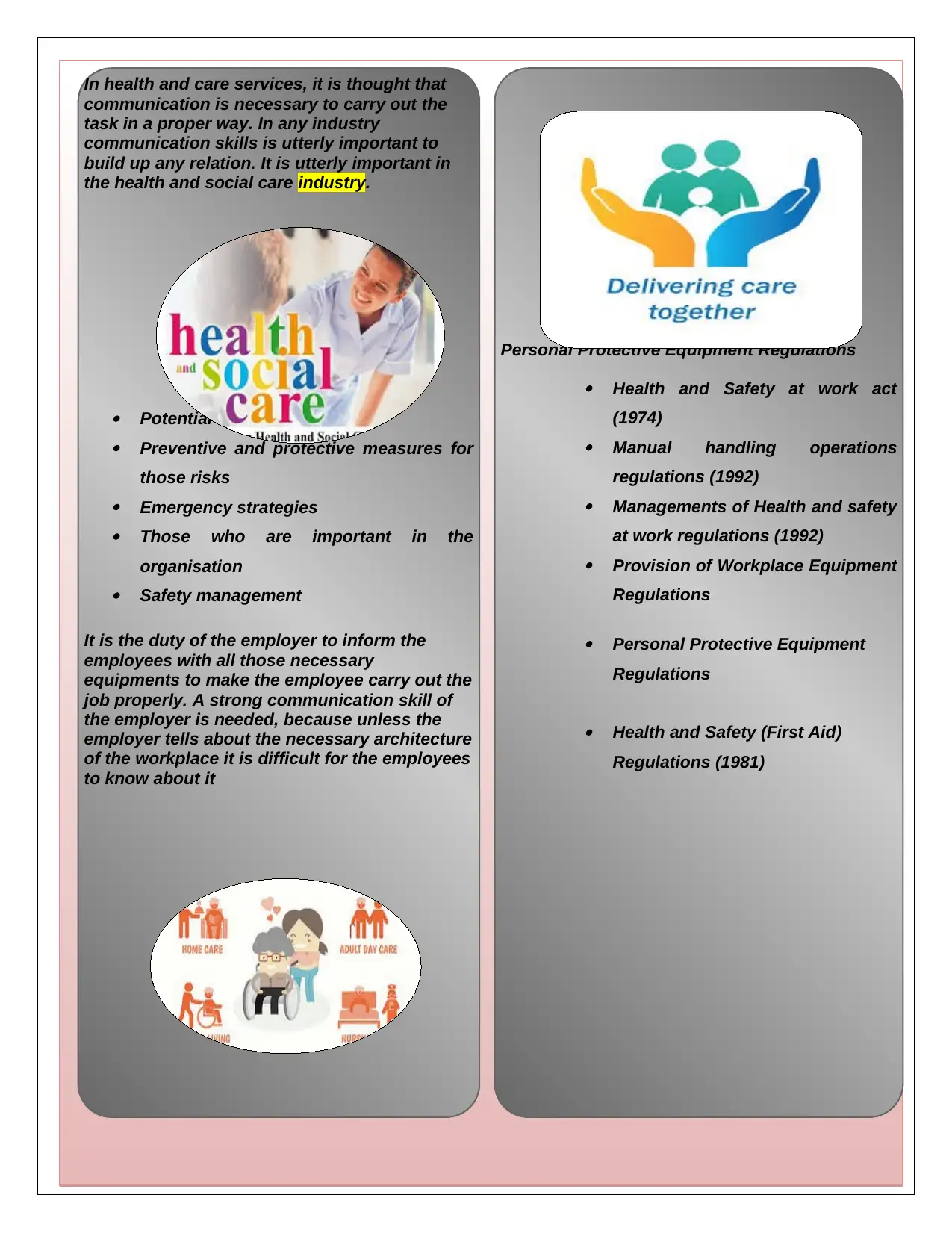
Health and Safety (First Aid) Regulations (1981)
8
In health and care services, it is thought that
communication is necessary to carry out the
task in a proper way. In any industry
communication skills is utterly important to
build up any relation. It is utterly important in
the health and social care industry.
Potential risks in the industry Preventive and protective measures for
those risks Emergency strategies Those who are important in the
organisation Safety management
It is the duty of the employer to inform the
employees with all those necessary
equipments to make the employee carry out the
job properly. A strong communication skill of
the employer is needed, because unless the
employer tells about the necessary architecture
of the workplace it is difficult for the employees
to know about it
Personal Protective Equipment Regulations
Health and Safety at work act
(1974)
Manual handling operations
regulations (1992)
Managements of Health and safety
at work regulations (1992)
Provision of Workplace Equipment
Regulations
Personal Protective Equipment
Regulations
Health and Safety (First Aid)
Regulations (1981)
Health and Safety (First Aid) Regulations (1981)
8
In health and care services, it is thought that
communication is necessary to carry out the
task in a proper way. In any industry
communication skills is utterly important to
build up any relation. It is utterly important in
the health and social care industry.
Potential risks in the industry Preventive and protective measures for
those risks Emergency strategies Those who are important in the
organisation Safety management
It is the duty of the employer to inform the
employees with all those necessary
equipments to make the employee carry out the
job properly. A strong communication skill of
the employer is needed, because unless the
employer tells about the necessary architecture
of the workplace it is difficult for the employees
to know about it
Personal Protective Equipment Regulations
Health and Safety at work act
(1974)
Manual handling operations
regulations (1992)
Managements of Health and safety
at work regulations (1992)
Provision of Workplace Equipment
Regulations
Personal Protective Equipment
Regulations
Health and Safety (First Aid)
Regulations (1981)
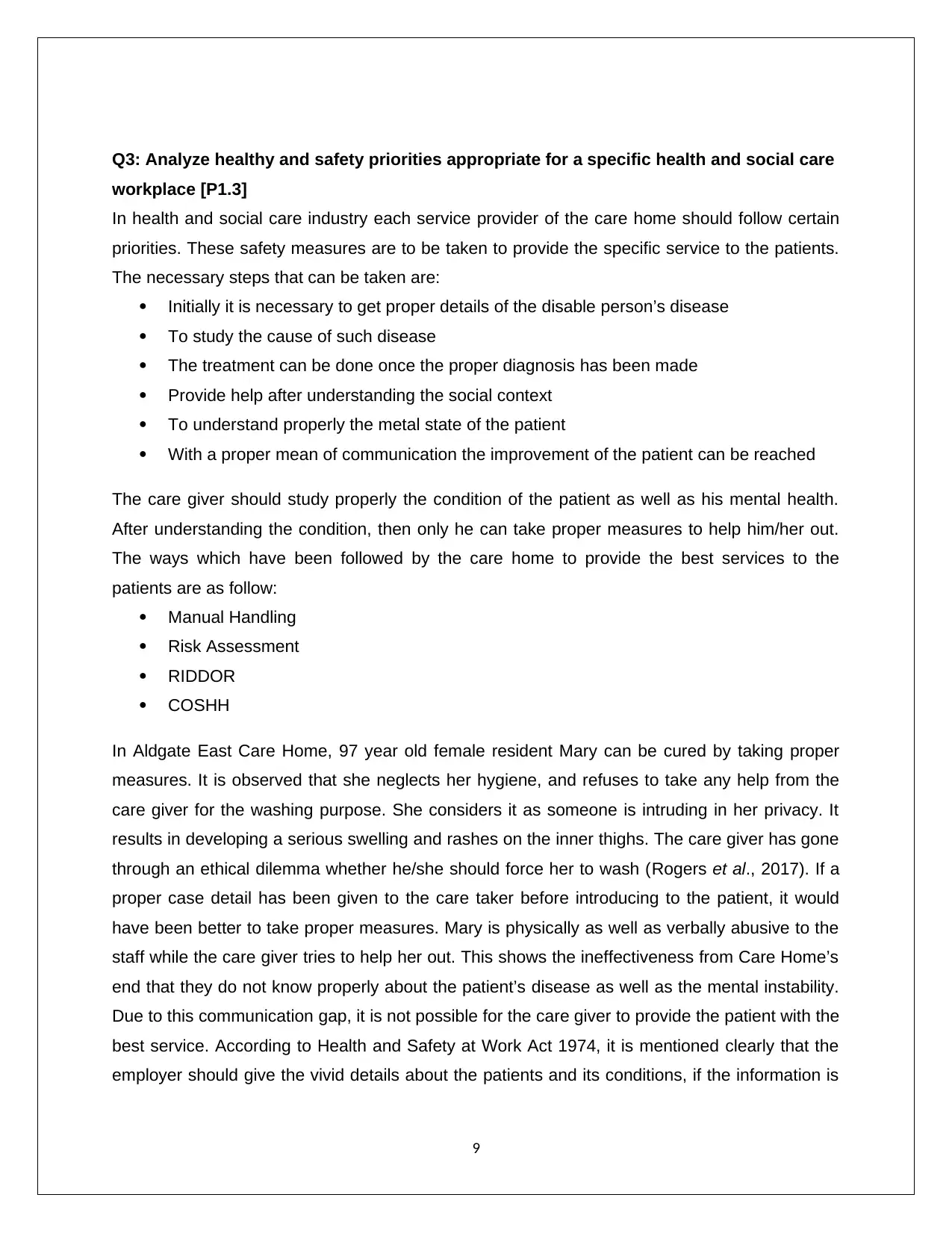
Q3: Analyze healthy and safety priorities appropriate for a specific health and social care
workplace [P1.3]
In health and social care industry each service provider of the care home should follow certain
priorities. These safety measures are to be taken to provide the specific service to the patients.
The necessary steps that can be taken are:
Initially it is necessary to get proper details of the disable person’s disease
To study the cause of such disease
The treatment can be done once the proper diagnosis has been made
Provide help after understanding the social context
To understand properly the metal state of the patient
With a proper mean of communication the improvement of the patient can be reached
The care giver should study properly the condition of the patient as well as his mental health.
After understanding the condition, then only he can take proper measures to help him/her out.
The ways which have been followed by the care home to provide the best services to the
patients are as follow:
Manual Handling
Risk Assessment
RIDDOR
COSHH
In Aldgate East Care Home, 97 year old female resident Mary can be cured by taking proper
measures. It is observed that she neglects her hygiene, and refuses to take any help from the
care giver for the washing purpose. She considers it as someone is intruding in her privacy. It
results in developing a serious swelling and rashes on the inner thighs. The care giver has gone
through an ethical dilemma whether he/she should force her to wash (Rogers et al., 2017). If a
proper case detail has been given to the care taker before introducing to the patient, it would
have been better to take proper measures. Mary is physically as well as verbally abusive to the
staff while the care giver tries to help her out. This shows the ineffectiveness from Care Home’s
end that they do not know properly about the patient’s disease as well as the mental instability.
Due to this communication gap, it is not possible for the care giver to provide the patient with the
best service. According to Health and Safety at Work Act 1974, it is mentioned clearly that the
employer should give the vivid details about the patients and its conditions, if the information is
9
workplace [P1.3]
In health and social care industry each service provider of the care home should follow certain
priorities. These safety measures are to be taken to provide the specific service to the patients.
The necessary steps that can be taken are:
Initially it is necessary to get proper details of the disable person’s disease
To study the cause of such disease
The treatment can be done once the proper diagnosis has been made
Provide help after understanding the social context
To understand properly the metal state of the patient
With a proper mean of communication the improvement of the patient can be reached
The care giver should study properly the condition of the patient as well as his mental health.
After understanding the condition, then only he can take proper measures to help him/her out.
The ways which have been followed by the care home to provide the best services to the
patients are as follow:
Manual Handling
Risk Assessment
RIDDOR
COSHH
In Aldgate East Care Home, 97 year old female resident Mary can be cured by taking proper
measures. It is observed that she neglects her hygiene, and refuses to take any help from the
care giver for the washing purpose. She considers it as someone is intruding in her privacy. It
results in developing a serious swelling and rashes on the inner thighs. The care giver has gone
through an ethical dilemma whether he/she should force her to wash (Rogers et al., 2017). If a
proper case detail has been given to the care taker before introducing to the patient, it would
have been better to take proper measures. Mary is physically as well as verbally abusive to the
staff while the care giver tries to help her out. This shows the ineffectiveness from Care Home’s
end that they do not know properly about the patient’s disease as well as the mental instability.
Due to this communication gap, it is not possible for the care giver to provide the patient with the
best service. According to Health and Safety at Work Act 1974, it is mentioned clearly that the
employer should give the vivid details about the patients and its conditions, if the information is
9
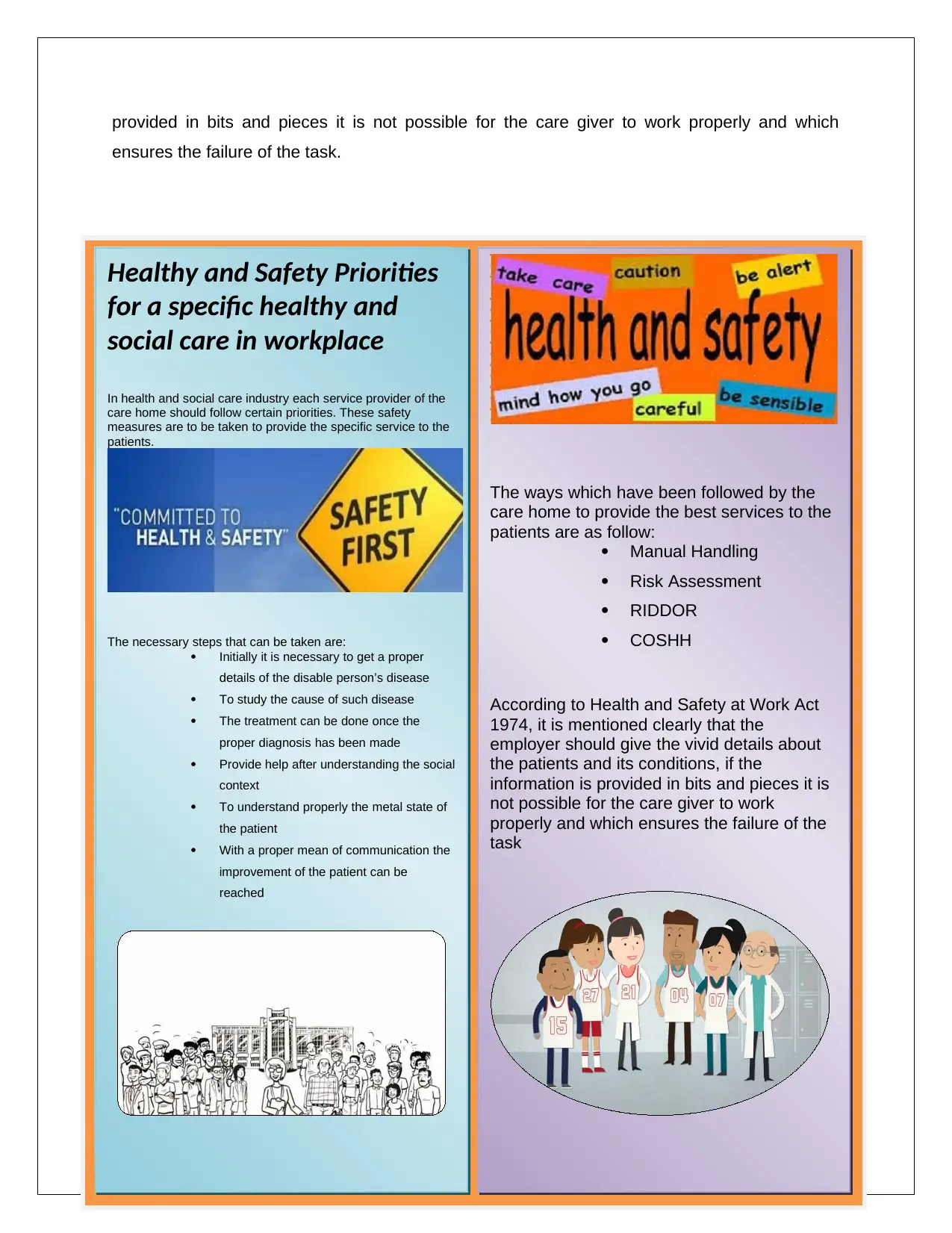
provided in bits and pieces it is not possible for the care giver to work properly and which
ensures the failure of the task.
10
Healthy and Safety Priorities
for a specific healthy and
social care in workplace
In health and social care industry each service provider of the
care home should follow certain priorities. These safety
measures are to be taken to provide the specific service to the
patients.
The necessary steps that can be taken are:
Initially it is necessary to get a proper
details of the disable person’s disease
To study the cause of such disease
The treatment can be done once the
proper diagnosis has been made
Provide help after understanding the social
context
To understand properly the metal state of
the patient
With a proper mean of communication the
improvement of the patient can be
reached
The ways which have been followed by the
care home to provide the best services to the
patients are as follow:
Manual Handling
Risk Assessment
RIDDOR
COSHH
According to Health and Safety at Work Act
1974, it is mentioned clearly that the
employer should give the vivid details about
the patients and its conditions, if the
information is provided in bits and pieces it is
not possible for the care giver to work
properly and which ensures the failure of the
task
ensures the failure of the task.
10
Healthy and Safety Priorities
for a specific healthy and
social care in workplace
In health and social care industry each service provider of the
care home should follow certain priorities. These safety
measures are to be taken to provide the specific service to the
patients.
The necessary steps that can be taken are:
Initially it is necessary to get a proper
details of the disable person’s disease
To study the cause of such disease
The treatment can be done once the
proper diagnosis has been made
Provide help after understanding the social
context
To understand properly the metal state of
the patient
With a proper mean of communication the
improvement of the patient can be
reached
The ways which have been followed by the
care home to provide the best services to the
patients are as follow:
Manual Handling
Risk Assessment
RIDDOR
COSHH
According to Health and Safety at Work Act
1974, it is mentioned clearly that the
employer should give the vivid details about
the patients and its conditions, if the
information is provided in bits and pieces it is
not possible for the care giver to work
properly and which ensures the failure of the
task
Secure Best Marks with AI Grader
Need help grading? Try our AI Grader for instant feedback on your assignments.
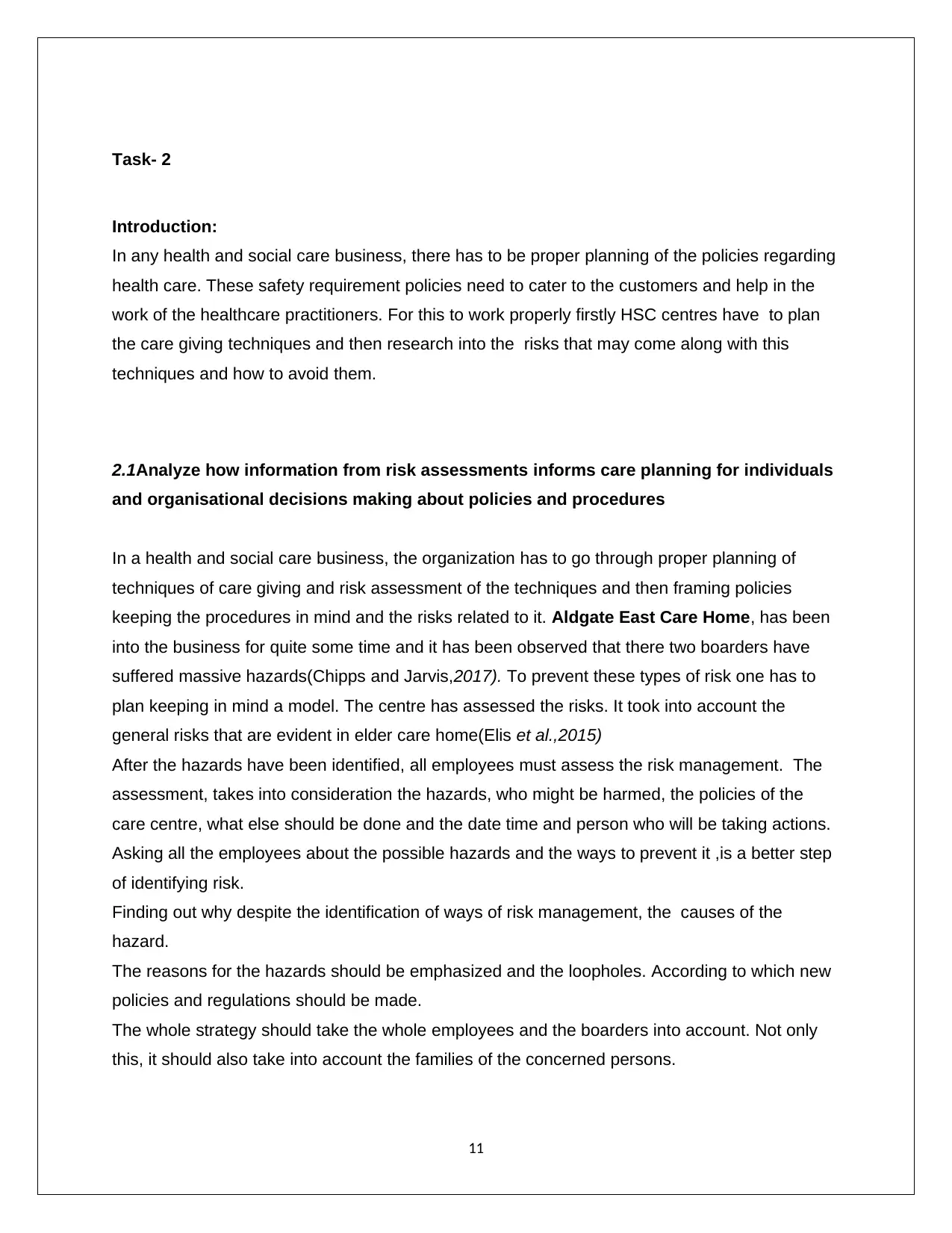
Task- 2
Introduction:
In any health and social care business, there has to be proper planning of the policies regarding
health care. These safety requirement policies need to cater to the customers and help in the
work of the healthcare practitioners. For this to work properly firstly HSC centres have to plan
the care giving techniques and then research into the risks that may come along with this
techniques and how to avoid them.
2.1Analyze how information from risk assessments informs care planning for individuals
and organisational decisions making about policies and procedures
In a health and social care business, the organization has to go through proper planning of
techniques of care giving and risk assessment of the techniques and then framing policies
keeping the procedures in mind and the risks related to it. Aldgate East Care Home, has been
into the business for quite some time and it has been observed that there two boarders have
suffered massive hazards(Chipps and Jarvis,2017). To prevent these types of risk one has to
plan keeping in mind a model. The centre has assessed the risks. It took into account the
general risks that are evident in elder care home(Elis et al.,2015)
After the hazards have been identified, all employees must assess the risk management. The
assessment, takes into consideration the hazards, who might be harmed, the policies of the
care centre, what else should be done and the date time and person who will be taking actions.
Asking all the employees about the possible hazards and the ways to prevent it ,is a better step
of identifying risk.
Finding out why despite the identification of ways of risk management, the causes of the
hazard.
The reasons for the hazards should be emphasized and the loopholes. According to which new
policies and regulations should be made.
The whole strategy should take the whole employees and the boarders into account. Not only
this, it should also take into account the families of the concerned persons.
11
Introduction:
In any health and social care business, there has to be proper planning of the policies regarding
health care. These safety requirement policies need to cater to the customers and help in the
work of the healthcare practitioners. For this to work properly firstly HSC centres have to plan
the care giving techniques and then research into the risks that may come along with this
techniques and how to avoid them.
2.1Analyze how information from risk assessments informs care planning for individuals
and organisational decisions making about policies and procedures
In a health and social care business, the organization has to go through proper planning of
techniques of care giving and risk assessment of the techniques and then framing policies
keeping the procedures in mind and the risks related to it. Aldgate East Care Home, has been
into the business for quite some time and it has been observed that there two boarders have
suffered massive hazards(Chipps and Jarvis,2017). To prevent these types of risk one has to
plan keeping in mind a model. The centre has assessed the risks. It took into account the
general risks that are evident in elder care home(Elis et al.,2015)
After the hazards have been identified, all employees must assess the risk management. The
assessment, takes into consideration the hazards, who might be harmed, the policies of the
care centre, what else should be done and the date time and person who will be taking actions.
Asking all the employees about the possible hazards and the ways to prevent it ,is a better step
of identifying risk.
Finding out why despite the identification of ways of risk management, the causes of the
hazard.
The reasons for the hazards should be emphasized and the loopholes. According to which new
policies and regulations should be made.
The whole strategy should take the whole employees and the boarders into account. Not only
this, it should also take into account the families of the concerned persons.
11
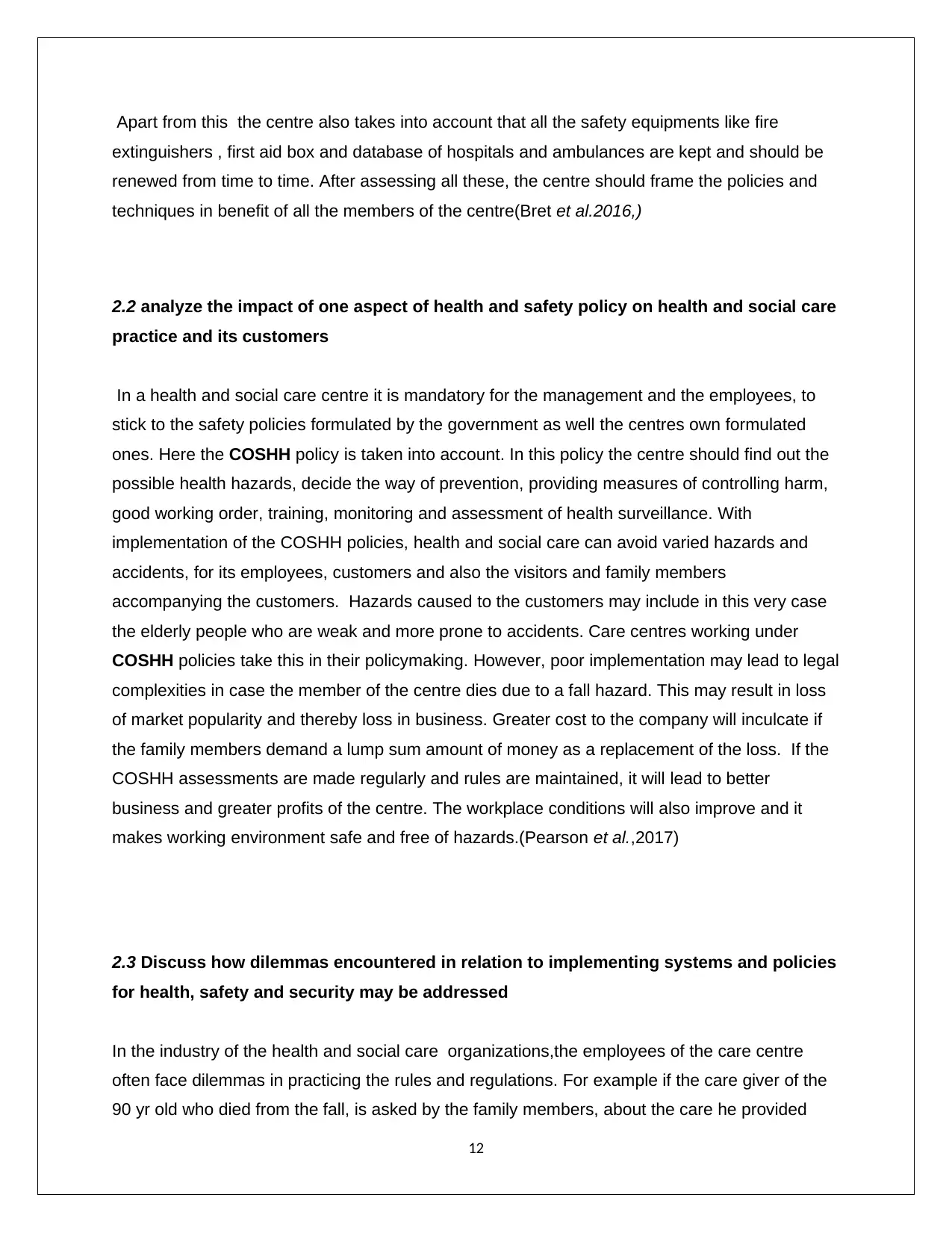
Apart from this the centre also takes into account that all the safety equipments like fire
extinguishers , first aid box and database of hospitals and ambulances are kept and should be
renewed from time to time. After assessing all these, the centre should frame the policies and
techniques in benefit of all the members of the centre(Bret et al.2016,)
2.2 analyze the impact of one aspect of health and safety policy on health and social care
practice and its customers
In a health and social care centre it is mandatory for the management and the employees, to
stick to the safety policies formulated by the government as well the centres own formulated
ones. Here the COSHH policy is taken into account. In this policy the centre should find out the
possible health hazards, decide the way of prevention, providing measures of controlling harm,
good working order, training, monitoring and assessment of health surveillance. With
implementation of the COSHH policies, health and social care can avoid varied hazards and
accidents, for its employees, customers and also the visitors and family members
accompanying the customers. Hazards caused to the customers may include in this very case
the elderly people who are weak and more prone to accidents. Care centres working under
COSHH policies take this in their policymaking. However, poor implementation may lead to legal
complexities in case the member of the centre dies due to a fall hazard. This may result in loss
of market popularity and thereby loss in business. Greater cost to the company will inculcate if
the family members demand a lump sum amount of money as a replacement of the loss. If the
COSHH assessments are made regularly and rules are maintained, it will lead to better
business and greater profits of the centre. The workplace conditions will also improve and it
makes working environment safe and free of hazards.(Pearson et al.,2017)
2.3 Discuss how dilemmas encountered in relation to implementing systems and policies
for health, safety and security may be addressed
In the industry of the health and social care organizations,the employees of the care centre
often face dilemmas in practicing the rules and regulations. For example if the care giver of the
90 yr old who died from the fall, is asked by the family members, about the care he provided
12
extinguishers , first aid box and database of hospitals and ambulances are kept and should be
renewed from time to time. After assessing all these, the centre should frame the policies and
techniques in benefit of all the members of the centre(Bret et al.2016,)
2.2 analyze the impact of one aspect of health and safety policy on health and social care
practice and its customers
In a health and social care centre it is mandatory for the management and the employees, to
stick to the safety policies formulated by the government as well the centres own formulated
ones. Here the COSHH policy is taken into account. In this policy the centre should find out the
possible health hazards, decide the way of prevention, providing measures of controlling harm,
good working order, training, monitoring and assessment of health surveillance. With
implementation of the COSHH policies, health and social care can avoid varied hazards and
accidents, for its employees, customers and also the visitors and family members
accompanying the customers. Hazards caused to the customers may include in this very case
the elderly people who are weak and more prone to accidents. Care centres working under
COSHH policies take this in their policymaking. However, poor implementation may lead to legal
complexities in case the member of the centre dies due to a fall hazard. This may result in loss
of market popularity and thereby loss in business. Greater cost to the company will inculcate if
the family members demand a lump sum amount of money as a replacement of the loss. If the
COSHH assessments are made regularly and rules are maintained, it will lead to better
business and greater profits of the centre. The workplace conditions will also improve and it
makes working environment safe and free of hazards.(Pearson et al.,2017)
2.3 Discuss how dilemmas encountered in relation to implementing systems and policies
for health, safety and security may be addressed
In the industry of the health and social care organizations,the employees of the care centre
often face dilemmas in practicing the rules and regulations. For example if the care giver of the
90 yr old who died from the fall, is asked by the family members, about the care he provided
12
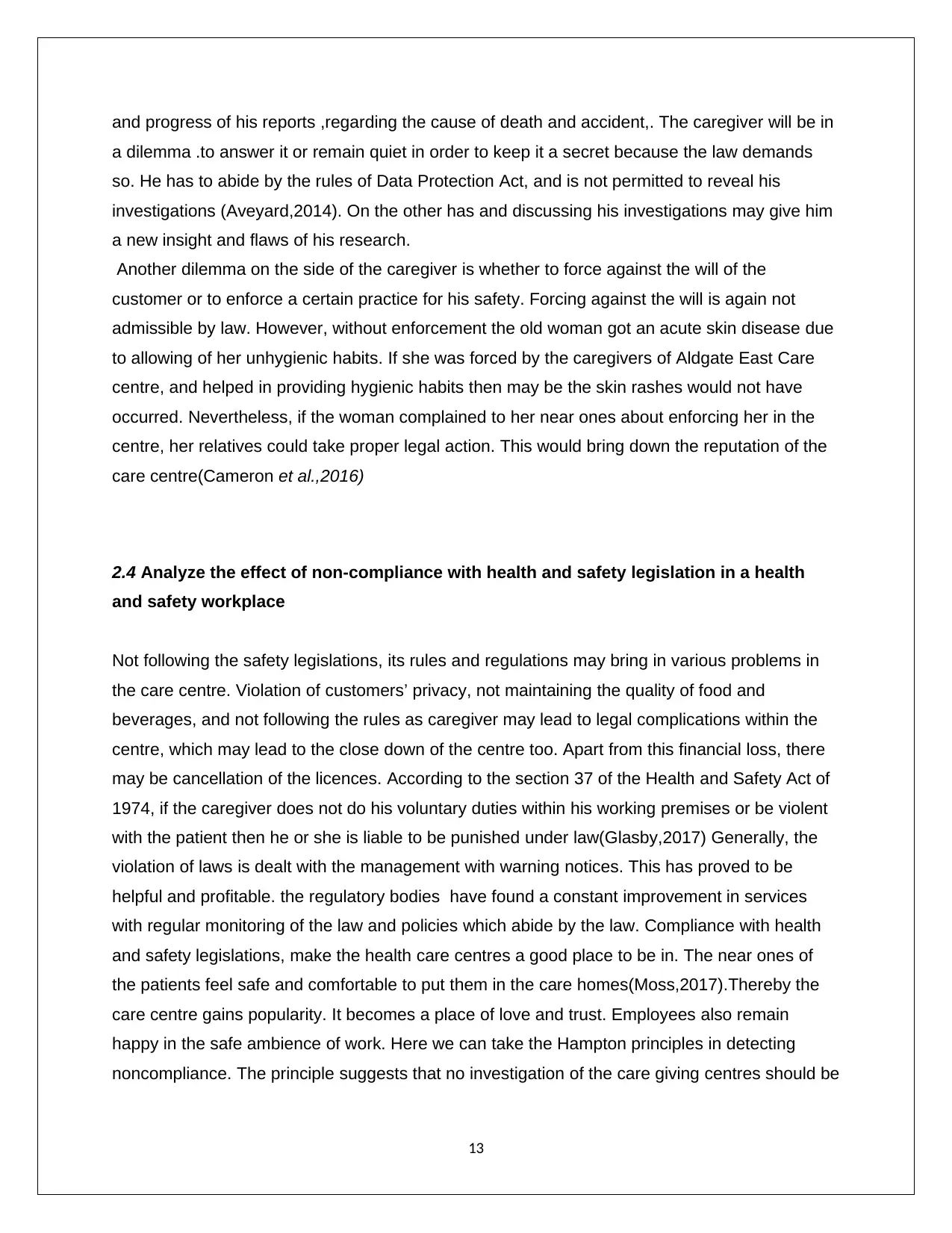
and progress of his reports ,regarding the cause of death and accident,. The caregiver will be in
a dilemma .to answer it or remain quiet in order to keep it a secret because the law demands
so. He has to abide by the rules of Data Protection Act, and is not permitted to reveal his
investigations (Aveyard,2014). On the other has and discussing his investigations may give him
a new insight and flaws of his research.
Another dilemma on the side of the caregiver is whether to force against the will of the
customer or to enforce a certain practice for his safety. Forcing against the will is again not
admissible by law. However, without enforcement the old woman got an acute skin disease due
to allowing of her unhygienic habits. If she was forced by the caregivers of Aldgate East Care
centre, and helped in providing hygienic habits then may be the skin rashes would not have
occurred. Nevertheless, if the woman complained to her near ones about enforcing her in the
centre, her relatives could take proper legal action. This would bring down the reputation of the
care centre(Cameron et al.,2016)
2.4 Analyze the effect of non-compliance with health and safety legislation in a health
and safety workplace
Not following the safety legislations, its rules and regulations may bring in various problems in
the care centre. Violation of customers’ privacy, not maintaining the quality of food and
beverages, and not following the rules as caregiver may lead to legal complications within the
centre, which may lead to the close down of the centre too. Apart from this financial loss, there
may be cancellation of the licences. According to the section 37 of the Health and Safety Act of
1974, if the caregiver does not do his voluntary duties within his working premises or be violent
with the patient then he or she is liable to be punished under law(Glasby,2017) Generally, the
violation of laws is dealt with the management with warning notices. This has proved to be
helpful and profitable. the regulatory bodies have found a constant improvement in services
with regular monitoring of the law and policies which abide by the law. Compliance with health
and safety legislations, make the health care centres a good place to be in. The near ones of
the patients feel safe and comfortable to put them in the care homes(Moss,2017).Thereby the
care centre gains popularity. It becomes a place of love and trust. Employees also remain
happy in the safe ambience of work. Here we can take the Hampton principles in detecting
noncompliance. The principle suggests that no investigation of the care giving centres should be
13
a dilemma .to answer it or remain quiet in order to keep it a secret because the law demands
so. He has to abide by the rules of Data Protection Act, and is not permitted to reveal his
investigations (Aveyard,2014). On the other has and discussing his investigations may give him
a new insight and flaws of his research.
Another dilemma on the side of the caregiver is whether to force against the will of the
customer or to enforce a certain practice for his safety. Forcing against the will is again not
admissible by law. However, without enforcement the old woman got an acute skin disease due
to allowing of her unhygienic habits. If she was forced by the caregivers of Aldgate East Care
centre, and helped in providing hygienic habits then may be the skin rashes would not have
occurred. Nevertheless, if the woman complained to her near ones about enforcing her in the
centre, her relatives could take proper legal action. This would bring down the reputation of the
care centre(Cameron et al.,2016)
2.4 Analyze the effect of non-compliance with health and safety legislation in a health
and safety workplace
Not following the safety legislations, its rules and regulations may bring in various problems in
the care centre. Violation of customers’ privacy, not maintaining the quality of food and
beverages, and not following the rules as caregiver may lead to legal complications within the
centre, which may lead to the close down of the centre too. Apart from this financial loss, there
may be cancellation of the licences. According to the section 37 of the Health and Safety Act of
1974, if the caregiver does not do his voluntary duties within his working premises or be violent
with the patient then he or she is liable to be punished under law(Glasby,2017) Generally, the
violation of laws is dealt with the management with warning notices. This has proved to be
helpful and profitable. the regulatory bodies have found a constant improvement in services
with regular monitoring of the law and policies which abide by the law. Compliance with health
and safety legislations, make the health care centres a good place to be in. The near ones of
the patients feel safe and comfortable to put them in the care homes(Moss,2017).Thereby the
care centre gains popularity. It becomes a place of love and trust. Employees also remain
happy in the safe ambience of work. Here we can take the Hampton principles in detecting
noncompliance. The principle suggests that no investigation of the care giving centres should be
13
Paraphrase This Document
Need a fresh take? Get an instant paraphrase of this document with our AI Paraphraser
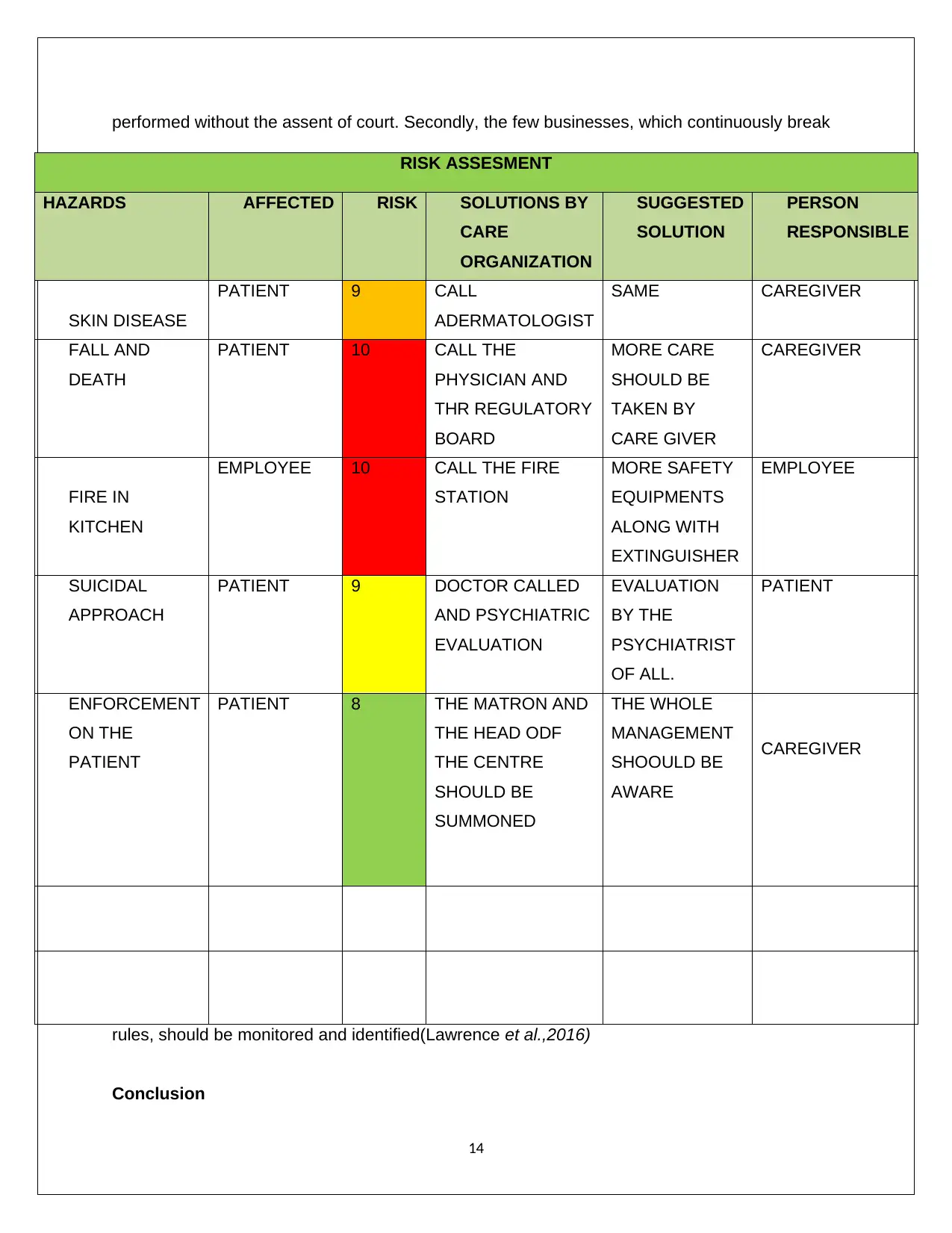
performed without the assent of court. Secondly, the few businesses, which continuously break
rules, should be monitored and identified(Lawrence et al.,2016)
Conclusion
14
RISK ASSESMENT
HAZARDS AFFECTED RISK SOLUTIONS BY
CARE
ORGANIZATION
SUGGESTED
SOLUTION
PERSON
RESPONSIBLE
SKIN DISEASE
PATIENT 9 CALL
ADERMATOLOGIST
SAME CAREGIVER
FALL AND
DEATH
PATIENT 10 CALL THE
PHYSICIAN AND
THR REGULATORY
BOARD
MORE CARE
SHOULD BE
TAKEN BY
CARE GIVER
CAREGIVER
FIRE IN
KITCHEN
EMPLOYEE 10 CALL THE FIRE
STATION
MORE SAFETY
EQUIPMENTS
ALONG WITH
EXTINGUISHER
EMPLOYEE
SUICIDAL
APPROACH
PATIENT 9 DOCTOR CALLED
AND PSYCHIATRIC
EVALUATION
EVALUATION
BY THE
PSYCHIATRIST
OF ALL.
PATIENT
ENFORCEMENT
ON THE
PATIENT
PATIENT 8 THE MATRON AND
THE HEAD ODF
THE CENTRE
SHOULD BE
SUMMONED
THE WHOLE
MANAGEMENT
SHOOULD BE
AWARE
CAREGIVER
rules, should be monitored and identified(Lawrence et al.,2016)
Conclusion
14
RISK ASSESMENT
HAZARDS AFFECTED RISK SOLUTIONS BY
CARE
ORGANIZATION
SUGGESTED
SOLUTION
PERSON
RESPONSIBLE
SKIN DISEASE
PATIENT 9 CALL
ADERMATOLOGIST
SAME CAREGIVER
FALL AND
DEATH
PATIENT 10 CALL THE
PHYSICIAN AND
THR REGULATORY
BOARD
MORE CARE
SHOULD BE
TAKEN BY
CARE GIVER
CAREGIVER
FIRE IN
KITCHEN
EMPLOYEE 10 CALL THE FIRE
STATION
MORE SAFETY
EQUIPMENTS
ALONG WITH
EXTINGUISHER
EMPLOYEE
SUICIDAL
APPROACH
PATIENT 9 DOCTOR CALLED
AND PSYCHIATRIC
EVALUATION
EVALUATION
BY THE
PSYCHIATRIST
OF ALL.
PATIENT
ENFORCEMENT
ON THE
PATIENT
PATIENT 8 THE MATRON AND
THE HEAD ODF
THE CENTRE
SHOULD BE
SUMMONED
THE WHOLE
MANAGEMENT
SHOOULD BE
AWARE
CAREGIVER
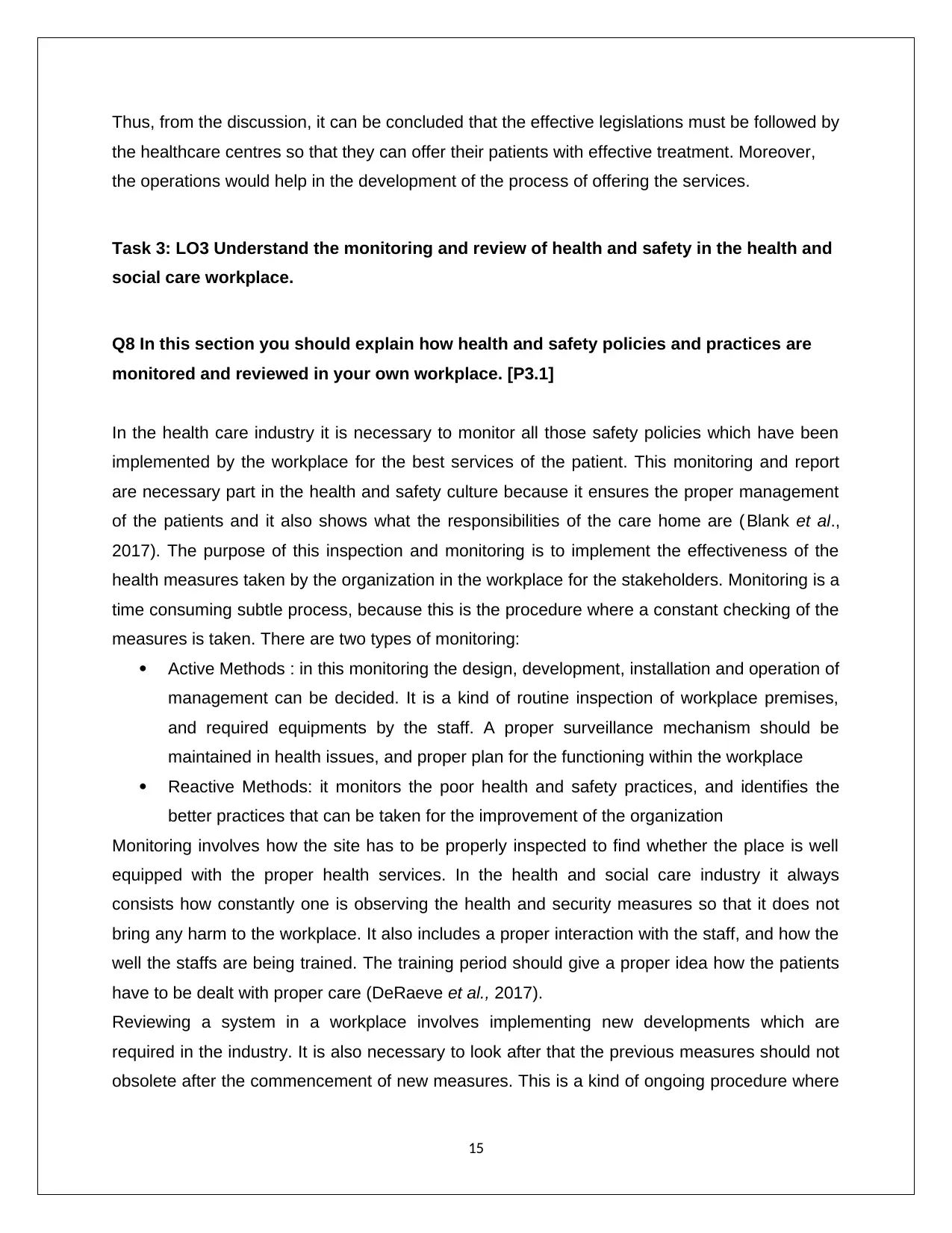
Thus, from the discussion, it can be concluded that the effective legislations must be followed by
the healthcare centres so that they can offer their patients with effective treatment. Moreover,
the operations would help in the development of the process of offering the services.
Task 3: LO3 Understand the monitoring and review of health and safety in the health and
social care workplace.
Q8 In this section you should explain how health and safety policies and practices are
monitored and reviewed in your own workplace. [P3.1]
In the health care industry it is necessary to monitor all those safety policies which have been
implemented by the workplace for the best services of the patient. This monitoring and report
are necessary part in the health and safety culture because it ensures the proper management
of the patients and it also shows what the responsibilities of the care home are ( Blank et al.,
2017). The purpose of this inspection and monitoring is to implement the effectiveness of the
health measures taken by the organization in the workplace for the stakeholders. Monitoring is a
time consuming subtle process, because this is the procedure where a constant checking of the
measures is taken. There are two types of monitoring:
Active Methods : in this monitoring the design, development, installation and operation of
management can be decided. It is a kind of routine inspection of workplace premises,
and required equipments by the staff. A proper surveillance mechanism should be
maintained in health issues, and proper plan for the functioning within the workplace
Reactive Methods: it monitors the poor health and safety practices, and identifies the
better practices that can be taken for the improvement of the organization
Monitoring involves how the site has to be properly inspected to find whether the place is well
equipped with the proper health services. In the health and social care industry it always
consists how constantly one is observing the health and security measures so that it does not
bring any harm to the workplace. It also includes a proper interaction with the staff, and how the
well the staffs are being trained. The training period should give a proper idea how the patients
have to be dealt with proper care (DeRaeve et al., 2017).
Reviewing a system in a workplace involves implementing new developments which are
required in the industry. It is also necessary to look after that the previous measures should not
obsolete after the commencement of new measures. This is a kind of ongoing procedure where
15
the healthcare centres so that they can offer their patients with effective treatment. Moreover,
the operations would help in the development of the process of offering the services.
Task 3: LO3 Understand the monitoring and review of health and safety in the health and
social care workplace.
Q8 In this section you should explain how health and safety policies and practices are
monitored and reviewed in your own workplace. [P3.1]
In the health care industry it is necessary to monitor all those safety policies which have been
implemented by the workplace for the best services of the patient. This monitoring and report
are necessary part in the health and safety culture because it ensures the proper management
of the patients and it also shows what the responsibilities of the care home are ( Blank et al.,
2017). The purpose of this inspection and monitoring is to implement the effectiveness of the
health measures taken by the organization in the workplace for the stakeholders. Monitoring is a
time consuming subtle process, because this is the procedure where a constant checking of the
measures is taken. There are two types of monitoring:
Active Methods : in this monitoring the design, development, installation and operation of
management can be decided. It is a kind of routine inspection of workplace premises,
and required equipments by the staff. A proper surveillance mechanism should be
maintained in health issues, and proper plan for the functioning within the workplace
Reactive Methods: it monitors the poor health and safety practices, and identifies the
better practices that can be taken for the improvement of the organization
Monitoring involves how the site has to be properly inspected to find whether the place is well
equipped with the proper health services. In the health and social care industry it always
consists how constantly one is observing the health and security measures so that it does not
bring any harm to the workplace. It also includes a proper interaction with the staff, and how the
well the staffs are being trained. The training period should give a proper idea how the patients
have to be dealt with proper care (DeRaeve et al., 2017).
Reviewing a system in a workplace involves implementing new developments which are
required in the industry. It is also necessary to look after that the previous measures should not
obsolete after the commencement of new measures. This is a kind of ongoing procedure where
15
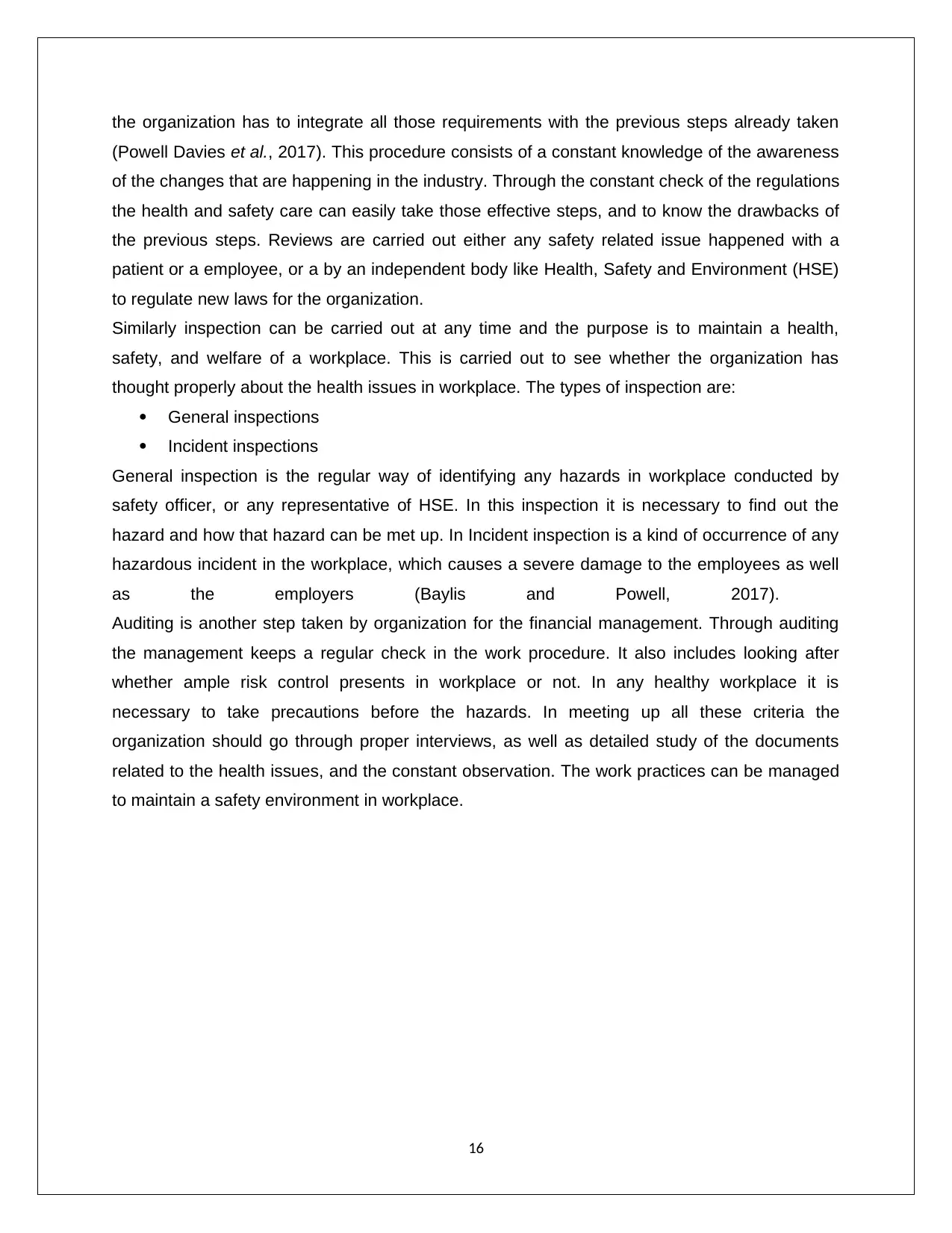
the organization has to integrate all those requirements with the previous steps already taken
(Powell Davies et al., 2017). This procedure consists of a constant knowledge of the awareness
of the changes that are happening in the industry. Through the constant check of the regulations
the health and safety care can easily take those effective steps, and to know the drawbacks of
the previous steps. Reviews are carried out either any safety related issue happened with a
patient or a employee, or a by an independent body like Health, Safety and Environment (HSE)
to regulate new laws for the organization.
Similarly inspection can be carried out at any time and the purpose is to maintain a health,
safety, and welfare of a workplace. This is carried out to see whether the organization has
thought properly about the health issues in workplace. The types of inspection are:
General inspections
Incident inspections
General inspection is the regular way of identifying any hazards in workplace conducted by
safety officer, or any representative of HSE. In this inspection it is necessary to find out the
hazard and how that hazard can be met up. In Incident inspection is a kind of occurrence of any
hazardous incident in the workplace, which causes a severe damage to the employees as well
as the employers (Baylis and Powell, 2017).
Auditing is another step taken by organization for the financial management. Through auditing
the management keeps a regular check in the work procedure. It also includes looking after
whether ample risk control presents in workplace or not. In any healthy workplace it is
necessary to take precautions before the hazards. In meeting up all these criteria the
organization should go through proper interviews, as well as detailed study of the documents
related to the health issues, and the constant observation. The work practices can be managed
to maintain a safety environment in workplace.
16
(Powell Davies et al., 2017). This procedure consists of a constant knowledge of the awareness
of the changes that are happening in the industry. Through the constant check of the regulations
the health and safety care can easily take those effective steps, and to know the drawbacks of
the previous steps. Reviews are carried out either any safety related issue happened with a
patient or a employee, or a by an independent body like Health, Safety and Environment (HSE)
to regulate new laws for the organization.
Similarly inspection can be carried out at any time and the purpose is to maintain a health,
safety, and welfare of a workplace. This is carried out to see whether the organization has
thought properly about the health issues in workplace. The types of inspection are:
General inspections
Incident inspections
General inspection is the regular way of identifying any hazards in workplace conducted by
safety officer, or any representative of HSE. In this inspection it is necessary to find out the
hazard and how that hazard can be met up. In Incident inspection is a kind of occurrence of any
hazardous incident in the workplace, which causes a severe damage to the employees as well
as the employers (Baylis and Powell, 2017).
Auditing is another step taken by organization for the financial management. Through auditing
the management keeps a regular check in the work procedure. It also includes looking after
whether ample risk control presents in workplace or not. In any healthy workplace it is
necessary to take precautions before the hazards. In meeting up all these criteria the
organization should go through proper interviews, as well as detailed study of the documents
related to the health issues, and the constant observation. The work practices can be managed
to maintain a safety environment in workplace.
16
Secure Best Marks with AI Grader
Need help grading? Try our AI Grader for instant feedback on your assignments.
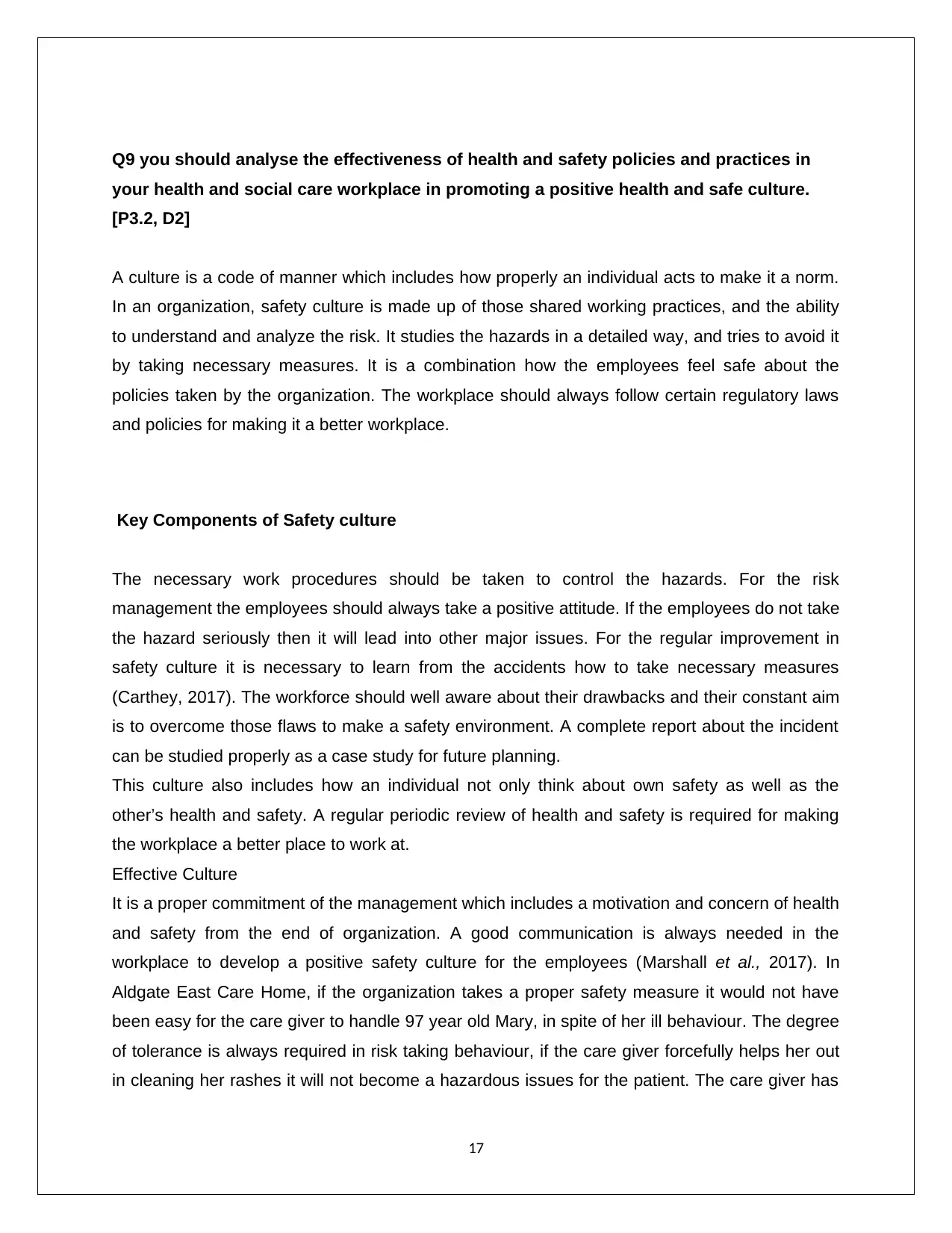
Q9 you should analyse the effectiveness of health and safety policies and practices in
your health and social care workplace in promoting a positive health and safe culture.
[P3.2, D2]
A culture is a code of manner which includes how properly an individual acts to make it a norm.
In an organization, safety culture is made up of those shared working practices, and the ability
to understand and analyze the risk. It studies the hazards in a detailed way, and tries to avoid it
by taking necessary measures. It is a combination how the employees feel safe about the
policies taken by the organization. The workplace should always follow certain regulatory laws
and policies for making it a better workplace.
Key Components of Safety culture
The necessary work procedures should be taken to control the hazards. For the risk
management the employees should always take a positive attitude. If the employees do not take
the hazard seriously then it will lead into other major issues. For the regular improvement in
safety culture it is necessary to learn from the accidents how to take necessary measures
(Carthey, 2017). The workforce should well aware about their drawbacks and their constant aim
is to overcome those flaws to make a safety environment. A complete report about the incident
can be studied properly as a case study for future planning.
This culture also includes how an individual not only think about own safety as well as the
other’s health and safety. A regular periodic review of health and safety is required for making
the workplace a better place to work at.
Effective Culture
It is a proper commitment of the management which includes a motivation and concern of health
and safety from the end of organization. A good communication is always needed in the
workplace to develop a positive safety culture for the employees (Marshall et al., 2017). In
Aldgate East Care Home, if the organization takes a proper safety measure it would not have
been easy for the care giver to handle 97 year old Mary, in spite of her ill behaviour. The degree
of tolerance is always required in risk taking behaviour, if the care giver forcefully helps her out
in cleaning her rashes it will not become a hazardous issues for the patient. The care giver has
17
your health and social care workplace in promoting a positive health and safe culture.
[P3.2, D2]
A culture is a code of manner which includes how properly an individual acts to make it a norm.
In an organization, safety culture is made up of those shared working practices, and the ability
to understand and analyze the risk. It studies the hazards in a detailed way, and tries to avoid it
by taking necessary measures. It is a combination how the employees feel safe about the
policies taken by the organization. The workplace should always follow certain regulatory laws
and policies for making it a better workplace.
Key Components of Safety culture
The necessary work procedures should be taken to control the hazards. For the risk
management the employees should always take a positive attitude. If the employees do not take
the hazard seriously then it will lead into other major issues. For the regular improvement in
safety culture it is necessary to learn from the accidents how to take necessary measures
(Carthey, 2017). The workforce should well aware about their drawbacks and their constant aim
is to overcome those flaws to make a safety environment. A complete report about the incident
can be studied properly as a case study for future planning.
This culture also includes how an individual not only think about own safety as well as the
other’s health and safety. A regular periodic review of health and safety is required for making
the workplace a better place to work at.
Effective Culture
It is a proper commitment of the management which includes a motivation and concern of health
and safety from the end of organization. A good communication is always needed in the
workplace to develop a positive safety culture for the employees (Marshall et al., 2017). In
Aldgate East Care Home, if the organization takes a proper safety measure it would not have
been easy for the care giver to handle 97 year old Mary, in spite of her ill behaviour. The degree
of tolerance is always required in risk taking behaviour, if the care giver forcefully helps her out
in cleaning her rashes it will not become a hazardous issues for the patient. The care giver has
17
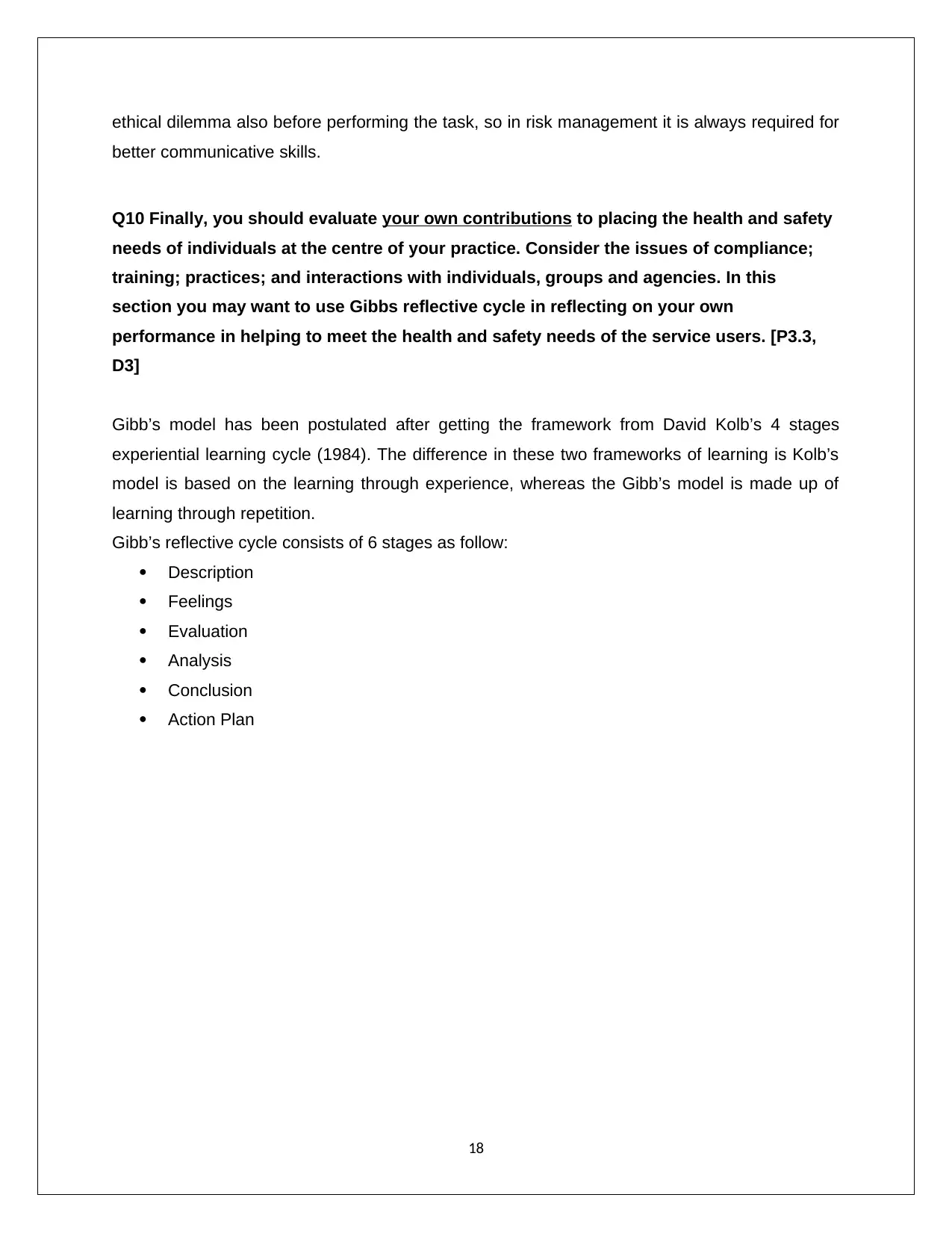
ethical dilemma also before performing the task, so in risk management it is always required for
better communicative skills.
Q10 Finally, you should evaluate your own contributions to placing the health and safety
needs of individuals at the centre of your practice. Consider the issues of compliance;
training; practices; and interactions with individuals, groups and agencies. In this
section you may want to use Gibbs reflective cycle in reflecting on your own
performance in helping to meet the health and safety needs of the service users. [P3.3,
D3]
Gibb’s model has been postulated after getting the framework from David Kolb’s 4 stages
experiential learning cycle (1984). The difference in these two frameworks of learning is Kolb’s
model is based on the learning through experience, whereas the Gibb’s model is made up of
learning through repetition.
Gibb’s reflective cycle consists of 6 stages as follow:
Description
Feelings
Evaluation
Analysis
Conclusion
Action Plan
18
better communicative skills.
Q10 Finally, you should evaluate your own contributions to placing the health and safety
needs of individuals at the centre of your practice. Consider the issues of compliance;
training; practices; and interactions with individuals, groups and agencies. In this
section you may want to use Gibbs reflective cycle in reflecting on your own
performance in helping to meet the health and safety needs of the service users. [P3.3,
D3]
Gibb’s model has been postulated after getting the framework from David Kolb’s 4 stages
experiential learning cycle (1984). The difference in these two frameworks of learning is Kolb’s
model is based on the learning through experience, whereas the Gibb’s model is made up of
learning through repetition.
Gibb’s reflective cycle consists of 6 stages as follow:
Description
Feelings
Evaluation
Analysis
Conclusion
Action Plan
18
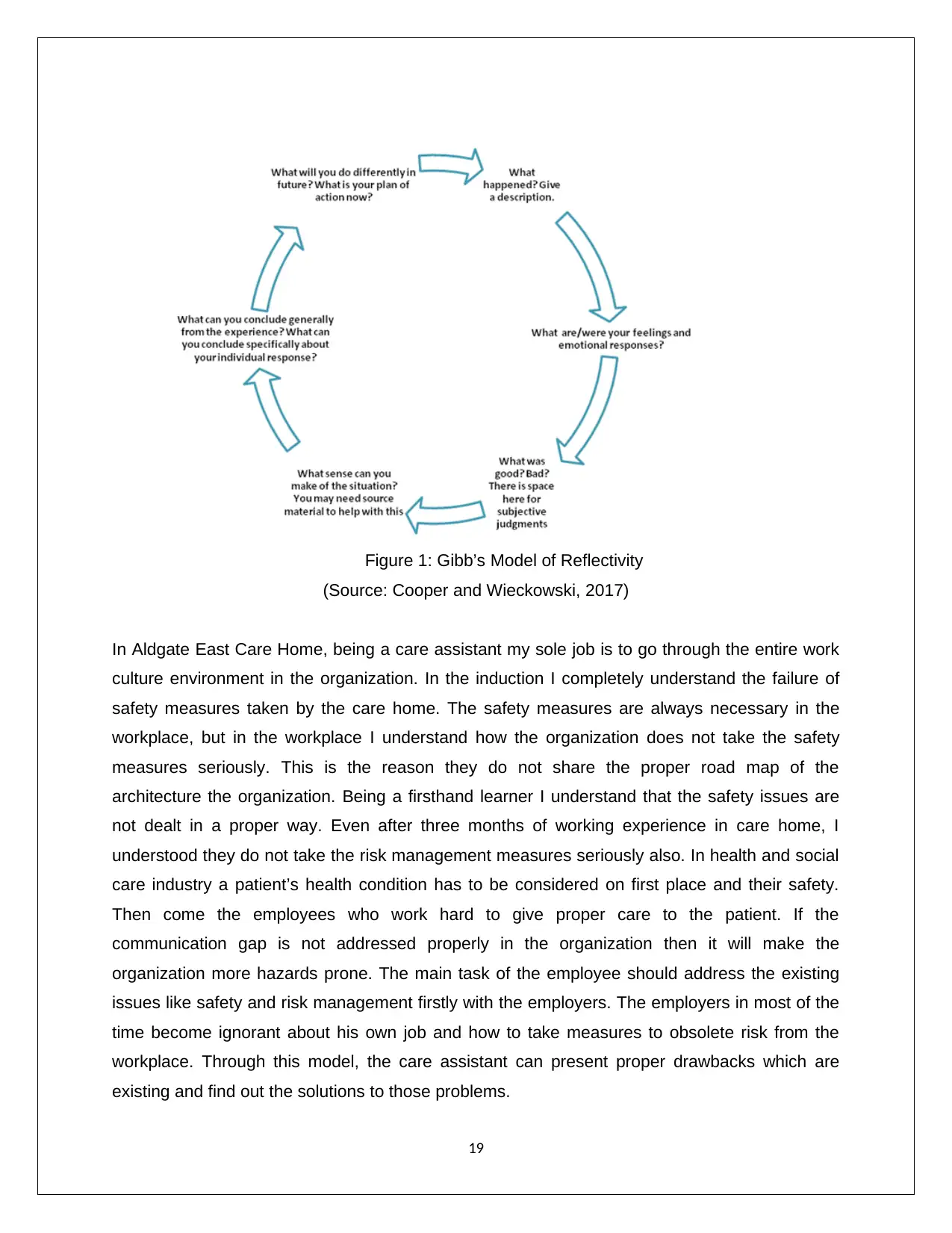
Figure 1: Gibb’s Model of Reflectivity
(Source: Cooper and Wieckowski, 2017)
In Aldgate East Care Home, being a care assistant my sole job is to go through the entire work
culture environment in the organization. In the induction I completely understand the failure of
safety measures taken by the care home. The safety measures are always necessary in the
workplace, but in the workplace I understand how the organization does not take the safety
measures seriously. This is the reason they do not share the proper road map of the
architecture the organization. Being a firsthand learner I understand that the safety issues are
not dealt in a proper way. Even after three months of working experience in care home, I
understood they do not take the risk management measures seriously also. In health and social
care industry a patient’s health condition has to be considered on first place and their safety.
Then come the employees who work hard to give proper care to the patient. If the
communication gap is not addressed properly in the organization then it will make the
organization more hazards prone. The main task of the employee should address the existing
issues like safety and risk management firstly with the employers. The employers in most of the
time become ignorant about his own job and how to take measures to obsolete risk from the
workplace. Through this model, the care assistant can present proper drawbacks which are
existing and find out the solutions to those problems.
19
(Source: Cooper and Wieckowski, 2017)
In Aldgate East Care Home, being a care assistant my sole job is to go through the entire work
culture environment in the organization. In the induction I completely understand the failure of
safety measures taken by the care home. The safety measures are always necessary in the
workplace, but in the workplace I understand how the organization does not take the safety
measures seriously. This is the reason they do not share the proper road map of the
architecture the organization. Being a firsthand learner I understand that the safety issues are
not dealt in a proper way. Even after three months of working experience in care home, I
understood they do not take the risk management measures seriously also. In health and social
care industry a patient’s health condition has to be considered on first place and their safety.
Then come the employees who work hard to give proper care to the patient. If the
communication gap is not addressed properly in the organization then it will make the
organization more hazards prone. The main task of the employee should address the existing
issues like safety and risk management firstly with the employers. The employers in most of the
time become ignorant about his own job and how to take measures to obsolete risk from the
workplace. Through this model, the care assistant can present proper drawbacks which are
existing and find out the solutions to those problems.
19
Paraphrase This Document
Need a fresh take? Get an instant paraphrase of this document with our AI Paraphraser
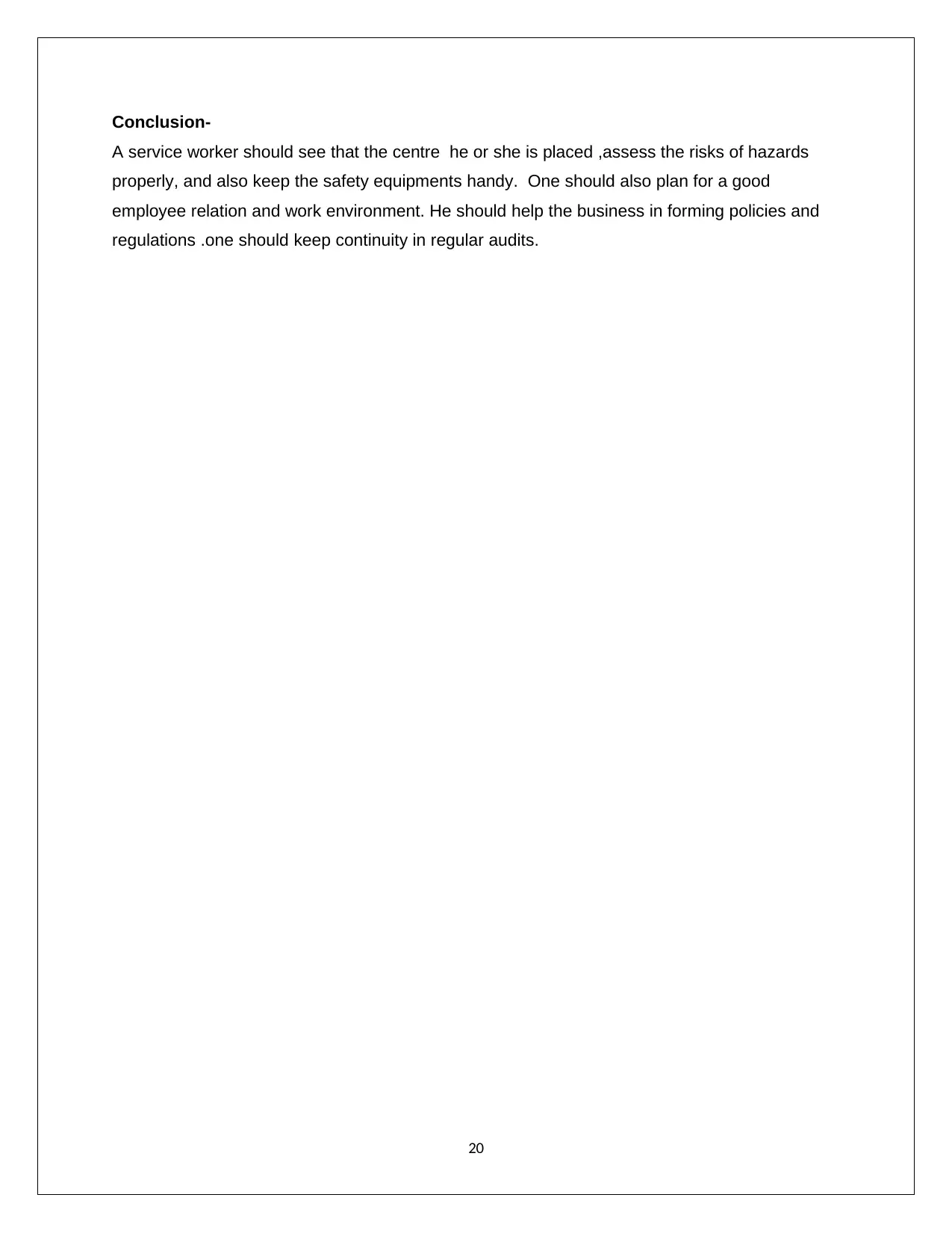
Conclusion-
A service worker should see that the centre he or she is placed ,assess the risks of hazards
properly, and also keep the safety equipments handy. One should also plan for a good
employee relation and work environment. He should help the business in forming policies and
regulations .one should keep continuity in regular audits.
20
A service worker should see that the centre he or she is placed ,assess the risks of hazards
properly, and also keep the safety equipments handy. One should also plan for a good
employee relation and work environment. He should help the business in forming policies and
regulations .one should keep continuity in regular audits.
20
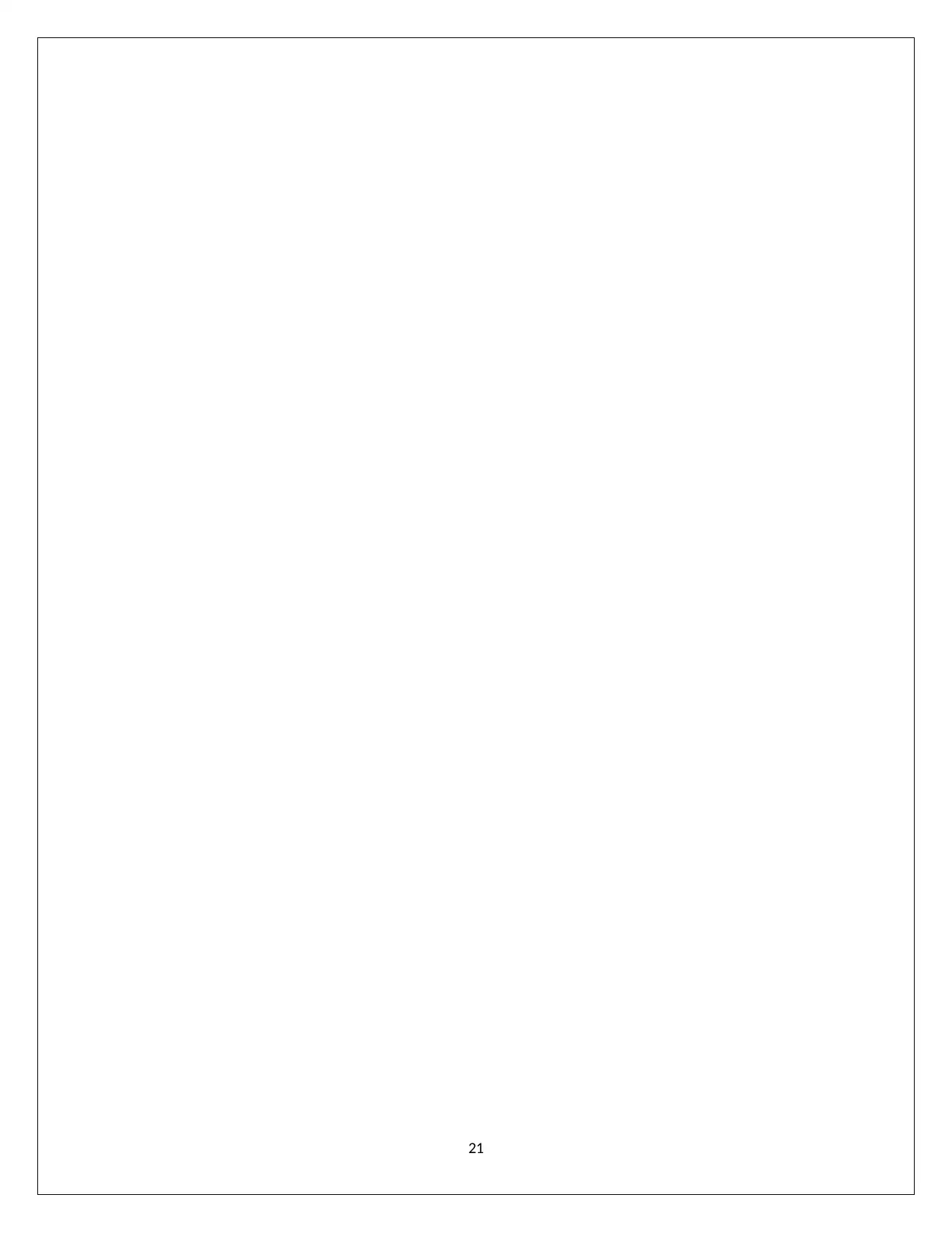
21
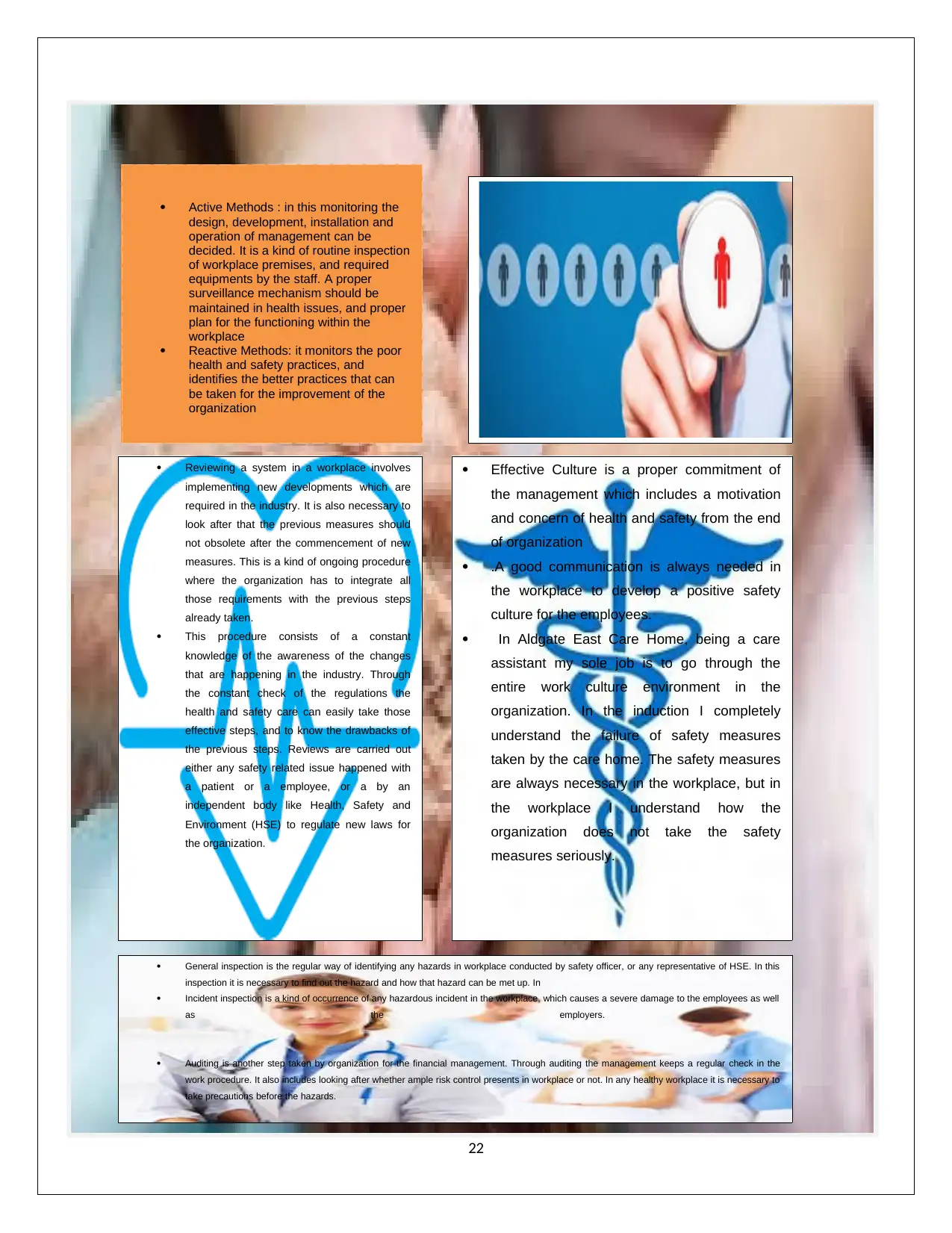
Reference
Abdool, R., 2017. Deception in caregiving: unpacking several ethical considerations in covert
medication. The Journal of Law, Medicine & Ethics, 45(2), pp.193-203.
Aveyard, H., 2014. Doing a literature review in health and social care: A practical guide.
McGraw-Hill Education (UK).
Baylis, A. and Powell, M., 2017. Health Care Systems' relationships with the public are an
essential factor if they are to survive financial pressures on the NHS in England. Management in
Healthcare, 2(1), pp.43-52.
Bibby, P., 2017. Personal safety for health care workers. Routledge.
Blank, R., Burau, V. and Kuhlmann, E., 2017. Comparative health policy. Macmillan
International Higher Education.
Brett, J., Staniszewska, S., Mockford, C., Herron‐Marx, S., Hughes, J., Tysall, C. and Suleman,
R., 2014. Mapping the impact of patient and public involvement on health and social care
research: a systematic review. Health Expectations,17(5), pp.637-650.
Burke, T., Galvin, M., Maguire, S., Pender, N. and Hardiman, O., 2018. The impact of cognitive
and behavioural change on quality of life of caregivers and patients with ALS and other
neurological conditions. Amyotrophic Lateral Sclerosis: Understanding and Optimizing Quality of
Life and Psychological Well-Being, p.151.
Cameron, A., Lart, R., Bostock, L. and Coomber, C., 2014. Factors that promote and hinder joint
and integrated working between health and social care services: a review of research
literature. Health & social care in the community, 22(3), pp.225-233.
Carthey, J., 2017. Improving Safety Culture in Healthcare Organisations. In Patient Safety
Culture (pp. 167-186). CRC Press.
Chipps, J. and Jarvis, M.A., 2016. Social capital and mental well-being of older people residing
in a residential care facility in Durban, South Africa. Aging & mental health, 20(12), pp.1264-
1270.
Cooper, L.D. and Wieckowski, A.T., 2017. A structured approach to reflective practice training in
a clinical practicum. Training and Education in Professional Psychology, 11(4), p.252.
De Raeve, P., Gomez, S., Hughes, P., Lyngholm, T., Sipilä, M., Kilanska, D., Hussey, P.,
Xyrichis, A. and ENS4Care project, 2017. Enhancing the provision of health and social care in
Europe through eH ealth. International nursing review, 64(1), pp.33-41.
22
Active Methods : in this monitoring the
design, development, installation and
operation of management can be
decided. It is a kind of routine inspection
of workplace premises, and required
equipments by the staff. A proper
surveillance mechanism should be
maintained in health issues, and proper
plan for the functioning within the
workplace
Reactive Methods: it monitors the poor
health and safety practices, and
identifies the better practices that can
be taken for the improvement of the
organization
Reviewing a system in a workplace involves
implementing new developments which are
required in the industry. It is also necessary to
look after that the previous measures should
not obsolete after the commencement of new
measures. This is a kind of ongoing procedure
where the organization has to integrate all
those requirements with the previous steps
already taken.
This procedure consists of a constant
knowledge of the awareness of the changes
that are happening in the industry. Through
the constant check of the regulations the
health and safety care can easily take those
effective steps, and to know the drawbacks of
the previous steps. Reviews are carried out
either any safety related issue happened with
a patient or a employee, or a by an
independent body like Health, Safety and
Environment (HSE) to regulate new laws for
the organization.
Effective Culture is a proper commitment of
the management which includes a motivation
and concern of health and safety from the end
of organization
.A good communication is always needed in
the workplace to develop a positive safety
culture for the employees.
In Aldgate East Care Home, being a care
assistant my sole job is to go through the
entire work culture environment in the
organization. In the induction I completely
understand the failure of safety measures
taken by the care home. The safety measures
are always necessary in the workplace, but in
the workplace I understand how the
organization does not take the safety
measures seriously.
General inspection is the regular way of identifying any hazards in workplace conducted by safety officer, or any representative of HSE. In this
inspection it is necessary to find out the hazard and how that hazard can be met up. In
Incident inspection is a kind of occurrence of any hazardous incident in the workplace, which causes a severe damage to the employees as well
as the employers.
Auditing is another step taken by organization for the financial management. Through auditing the management keeps a regular check in the
work procedure. It also includes looking after whether ample risk control presents in workplace or not. In any healthy workplace it is necessary to
take precautions before the hazards.
Abdool, R., 2017. Deception in caregiving: unpacking several ethical considerations in covert
medication. The Journal of Law, Medicine & Ethics, 45(2), pp.193-203.
Aveyard, H., 2014. Doing a literature review in health and social care: A practical guide.
McGraw-Hill Education (UK).
Baylis, A. and Powell, M., 2017. Health Care Systems' relationships with the public are an
essential factor if they are to survive financial pressures on the NHS in England. Management in
Healthcare, 2(1), pp.43-52.
Bibby, P., 2017. Personal safety for health care workers. Routledge.
Blank, R., Burau, V. and Kuhlmann, E., 2017. Comparative health policy. Macmillan
International Higher Education.
Brett, J., Staniszewska, S., Mockford, C., Herron‐Marx, S., Hughes, J., Tysall, C. and Suleman,
R., 2014. Mapping the impact of patient and public involvement on health and social care
research: a systematic review. Health Expectations,17(5), pp.637-650.
Burke, T., Galvin, M., Maguire, S., Pender, N. and Hardiman, O., 2018. The impact of cognitive
and behavioural change on quality of life of caregivers and patients with ALS and other
neurological conditions. Amyotrophic Lateral Sclerosis: Understanding and Optimizing Quality of
Life and Psychological Well-Being, p.151.
Cameron, A., Lart, R., Bostock, L. and Coomber, C., 2014. Factors that promote and hinder joint
and integrated working between health and social care services: a review of research
literature. Health & social care in the community, 22(3), pp.225-233.
Carthey, J., 2017. Improving Safety Culture in Healthcare Organisations. In Patient Safety
Culture (pp. 167-186). CRC Press.
Chipps, J. and Jarvis, M.A., 2016. Social capital and mental well-being of older people residing
in a residential care facility in Durban, South Africa. Aging & mental health, 20(12), pp.1264-
1270.
Cooper, L.D. and Wieckowski, A.T., 2017. A structured approach to reflective practice training in
a clinical practicum. Training and Education in Professional Psychology, 11(4), p.252.
De Raeve, P., Gomez, S., Hughes, P., Lyngholm, T., Sipilä, M., Kilanska, D., Hussey, P.,
Xyrichis, A. and ENS4Care project, 2017. Enhancing the provision of health and social care in
Europe through eH ealth. International nursing review, 64(1), pp.33-41.
22
Active Methods : in this monitoring the
design, development, installation and
operation of management can be
decided. It is a kind of routine inspection
of workplace premises, and required
equipments by the staff. A proper
surveillance mechanism should be
maintained in health issues, and proper
plan for the functioning within the
workplace
Reactive Methods: it monitors the poor
health and safety practices, and
identifies the better practices that can
be taken for the improvement of the
organization
Reviewing a system in a workplace involves
implementing new developments which are
required in the industry. It is also necessary to
look after that the previous measures should
not obsolete after the commencement of new
measures. This is a kind of ongoing procedure
where the organization has to integrate all
those requirements with the previous steps
already taken.
This procedure consists of a constant
knowledge of the awareness of the changes
that are happening in the industry. Through
the constant check of the regulations the
health and safety care can easily take those
effective steps, and to know the drawbacks of
the previous steps. Reviews are carried out
either any safety related issue happened with
a patient or a employee, or a by an
independent body like Health, Safety and
Environment (HSE) to regulate new laws for
the organization.
Effective Culture is a proper commitment of
the management which includes a motivation
and concern of health and safety from the end
of organization
.A good communication is always needed in
the workplace to develop a positive safety
culture for the employees.
In Aldgate East Care Home, being a care
assistant my sole job is to go through the
entire work culture environment in the
organization. In the induction I completely
understand the failure of safety measures
taken by the care home. The safety measures
are always necessary in the workplace, but in
the workplace I understand how the
organization does not take the safety
measures seriously.
General inspection is the regular way of identifying any hazards in workplace conducted by safety officer, or any representative of HSE. In this
inspection it is necessary to find out the hazard and how that hazard can be met up. In
Incident inspection is a kind of occurrence of any hazardous incident in the workplace, which causes a severe damage to the employees as well
as the employers.
Auditing is another step taken by organization for the financial management. Through auditing the management keeps a regular check in the
work procedure. It also includes looking after whether ample risk control presents in workplace or not. In any healthy workplace it is necessary to
take precautions before the hazards.
Secure Best Marks with AI Grader
Need help grading? Try our AI Grader for instant feedback on your assignments.
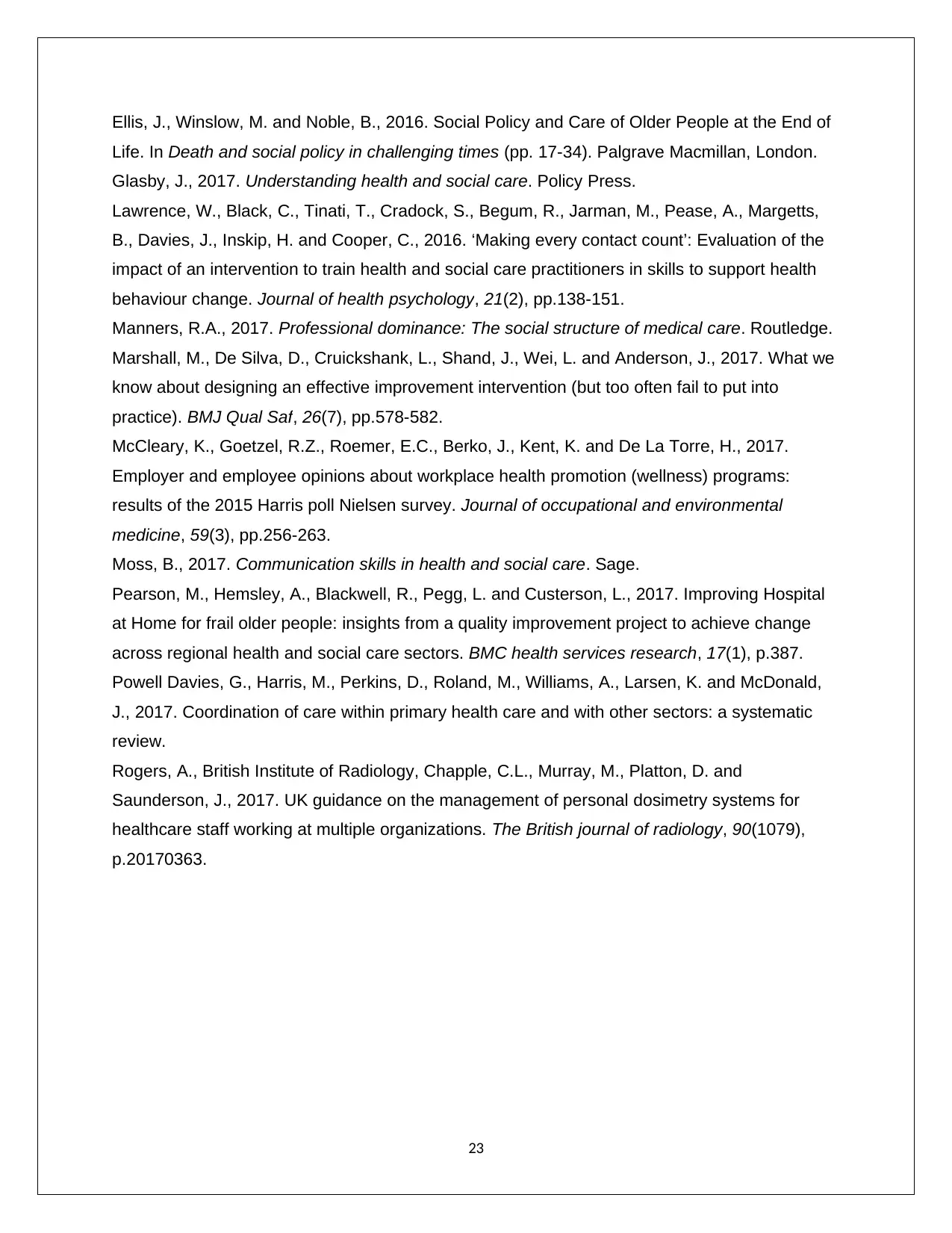
Ellis, J., Winslow, M. and Noble, B., 2016. Social Policy and Care of Older People at the End of
Life. In Death and social policy in challenging times (pp. 17-34). Palgrave Macmillan, London.
Glasby, J., 2017. Understanding health and social care. Policy Press.
Lawrence, W., Black, C., Tinati, T., Cradock, S., Begum, R., Jarman, M., Pease, A., Margetts,
B., Davies, J., Inskip, H. and Cooper, C., 2016. ‘Making every contact count’: Evaluation of the
impact of an intervention to train health and social care practitioners in skills to support health
behaviour change. Journal of health psychology, 21(2), pp.138-151.
Manners, R.A., 2017. Professional dominance: The social structure of medical care. Routledge.
Marshall, M., De Silva, D., Cruickshank, L., Shand, J., Wei, L. and Anderson, J., 2017. What we
know about designing an effective improvement intervention (but too often fail to put into
practice). BMJ Qual Saf, 26(7), pp.578-582.
McCleary, K., Goetzel, R.Z., Roemer, E.C., Berko, J., Kent, K. and De La Torre, H., 2017.
Employer and employee opinions about workplace health promotion (wellness) programs:
results of the 2015 Harris poll Nielsen survey. Journal of occupational and environmental
medicine, 59(3), pp.256-263.
Moss, B., 2017. Communication skills in health and social care. Sage.
Pearson, M., Hemsley, A., Blackwell, R., Pegg, L. and Custerson, L., 2017. Improving Hospital
at Home for frail older people: insights from a quality improvement project to achieve change
across regional health and social care sectors. BMC health services research, 17(1), p.387.
Powell Davies, G., Harris, M., Perkins, D., Roland, M., Williams, A., Larsen, K. and McDonald,
J., 2017. Coordination of care within primary health care and with other sectors: a systematic
review.
Rogers, A., British Institute of Radiology, Chapple, C.L., Murray, M., Platton, D. and
Saunderson, J., 2017. UK guidance on the management of personal dosimetry systems for
healthcare staff working at multiple organizations. The British journal of radiology, 90(1079),
p.20170363.
23
Life. In Death and social policy in challenging times (pp. 17-34). Palgrave Macmillan, London.
Glasby, J., 2017. Understanding health and social care. Policy Press.
Lawrence, W., Black, C., Tinati, T., Cradock, S., Begum, R., Jarman, M., Pease, A., Margetts,
B., Davies, J., Inskip, H. and Cooper, C., 2016. ‘Making every contact count’: Evaluation of the
impact of an intervention to train health and social care practitioners in skills to support health
behaviour change. Journal of health psychology, 21(2), pp.138-151.
Manners, R.A., 2017. Professional dominance: The social structure of medical care. Routledge.
Marshall, M., De Silva, D., Cruickshank, L., Shand, J., Wei, L. and Anderson, J., 2017. What we
know about designing an effective improvement intervention (but too often fail to put into
practice). BMJ Qual Saf, 26(7), pp.578-582.
McCleary, K., Goetzel, R.Z., Roemer, E.C., Berko, J., Kent, K. and De La Torre, H., 2017.
Employer and employee opinions about workplace health promotion (wellness) programs:
results of the 2015 Harris poll Nielsen survey. Journal of occupational and environmental
medicine, 59(3), pp.256-263.
Moss, B., 2017. Communication skills in health and social care. Sage.
Pearson, M., Hemsley, A., Blackwell, R., Pegg, L. and Custerson, L., 2017. Improving Hospital
at Home for frail older people: insights from a quality improvement project to achieve change
across regional health and social care sectors. BMC health services research, 17(1), p.387.
Powell Davies, G., Harris, M., Perkins, D., Roland, M., Williams, A., Larsen, K. and McDonald,
J., 2017. Coordination of care within primary health care and with other sectors: a systematic
review.
Rogers, A., British Institute of Radiology, Chapple, C.L., Murray, M., Platton, D. and
Saunderson, J., 2017. UK guidance on the management of personal dosimetry systems for
healthcare staff working at multiple organizations. The British journal of radiology, 90(1079),
p.20170363.
23
1 out of 23
Related Documents
Your All-in-One AI-Powered Toolkit for Academic Success.
+13062052269
info@desklib.com
Available 24*7 on WhatsApp / Email
![[object Object]](/_next/static/media/star-bottom.7253800d.svg)
Unlock your academic potential
© 2024 | Zucol Services PVT LTD | All rights reserved.





